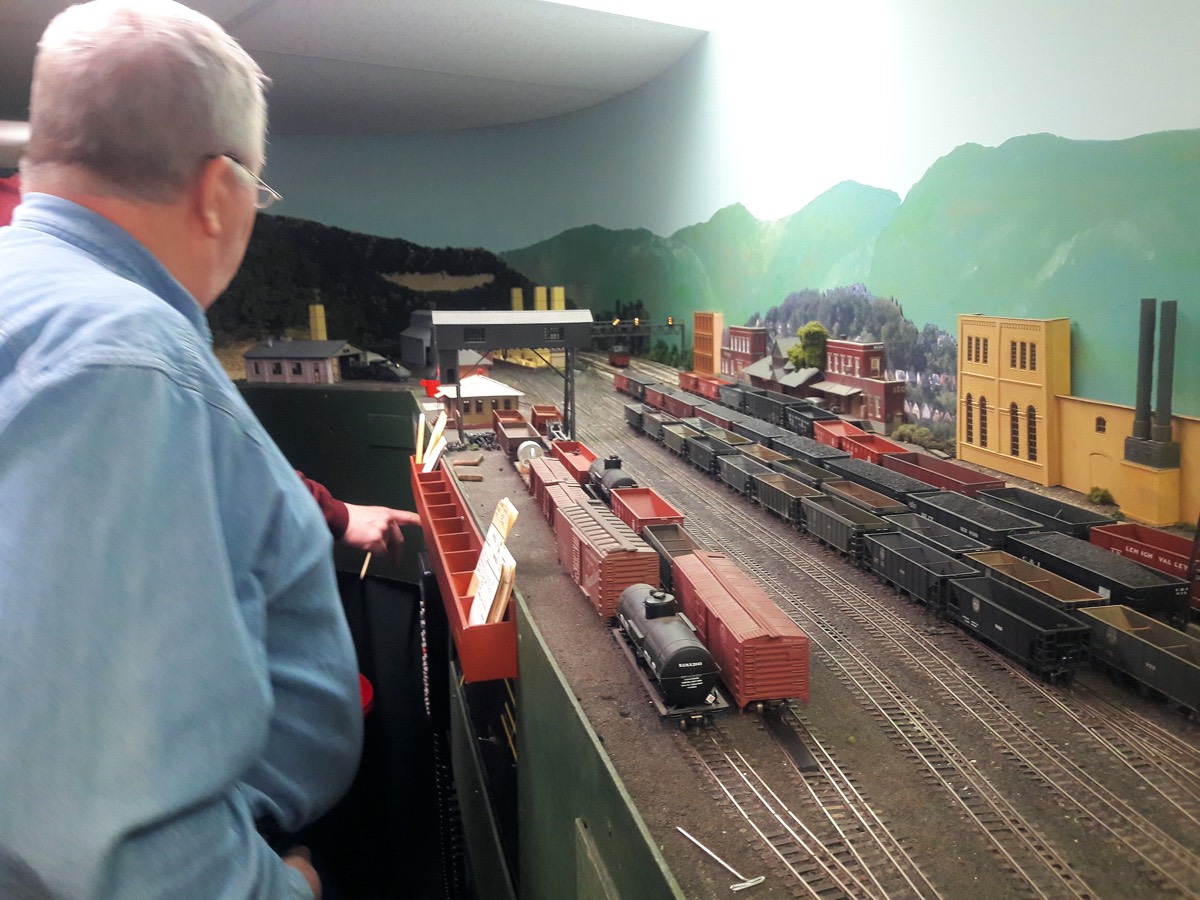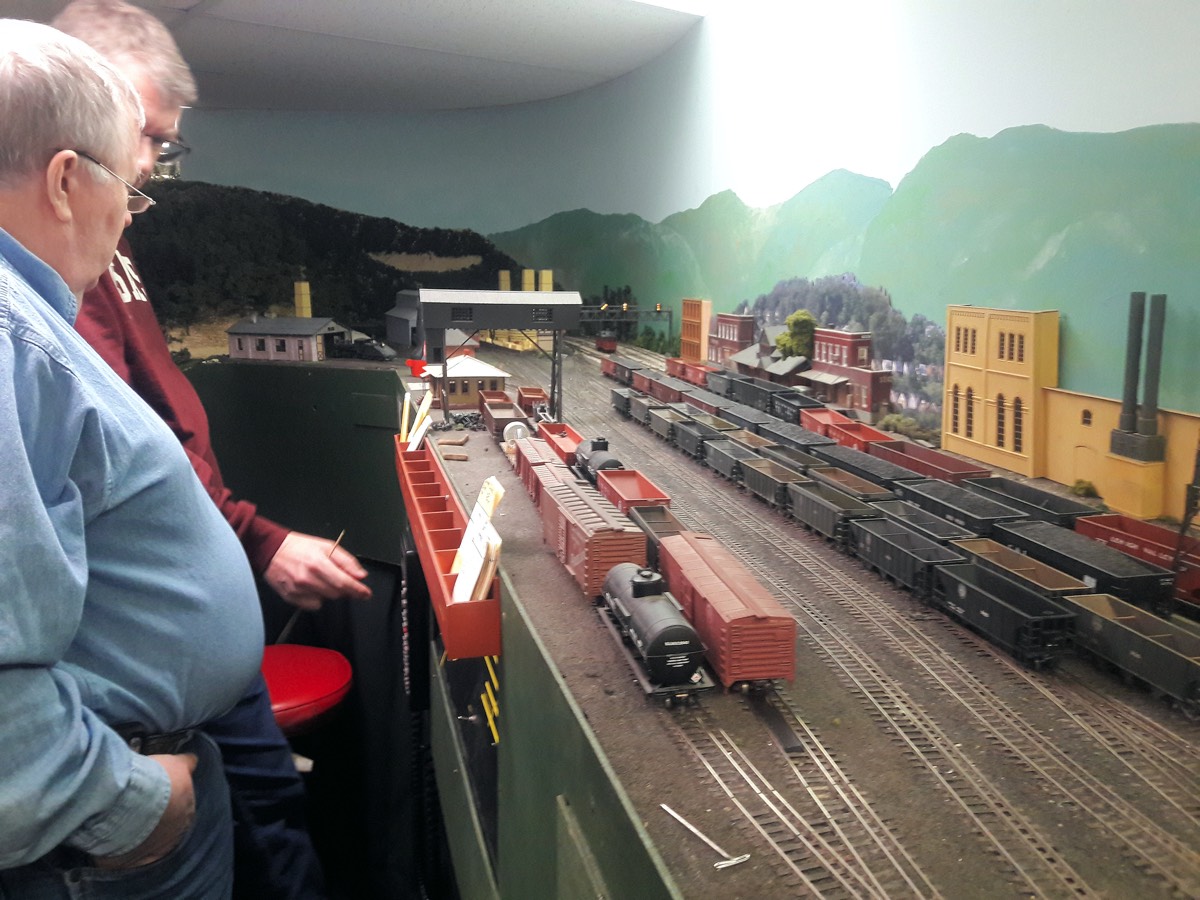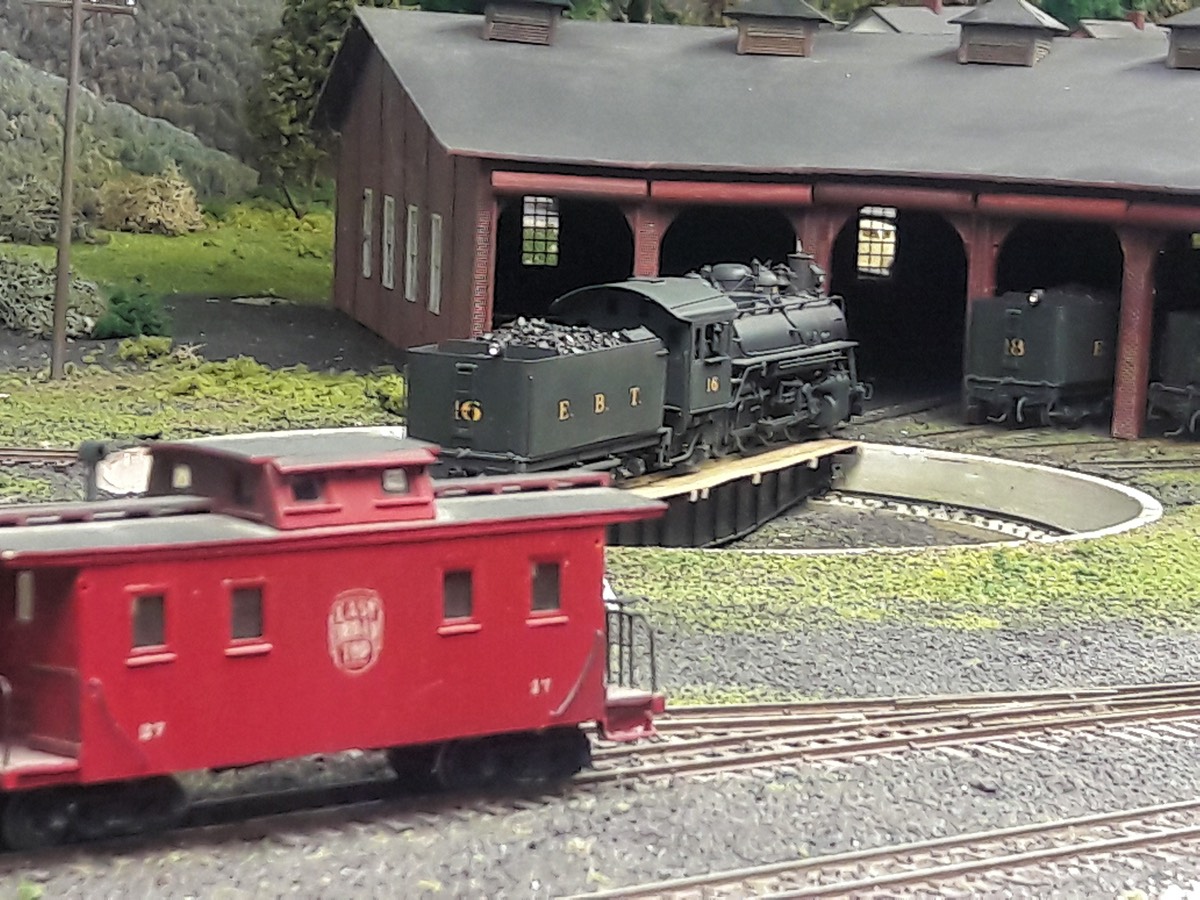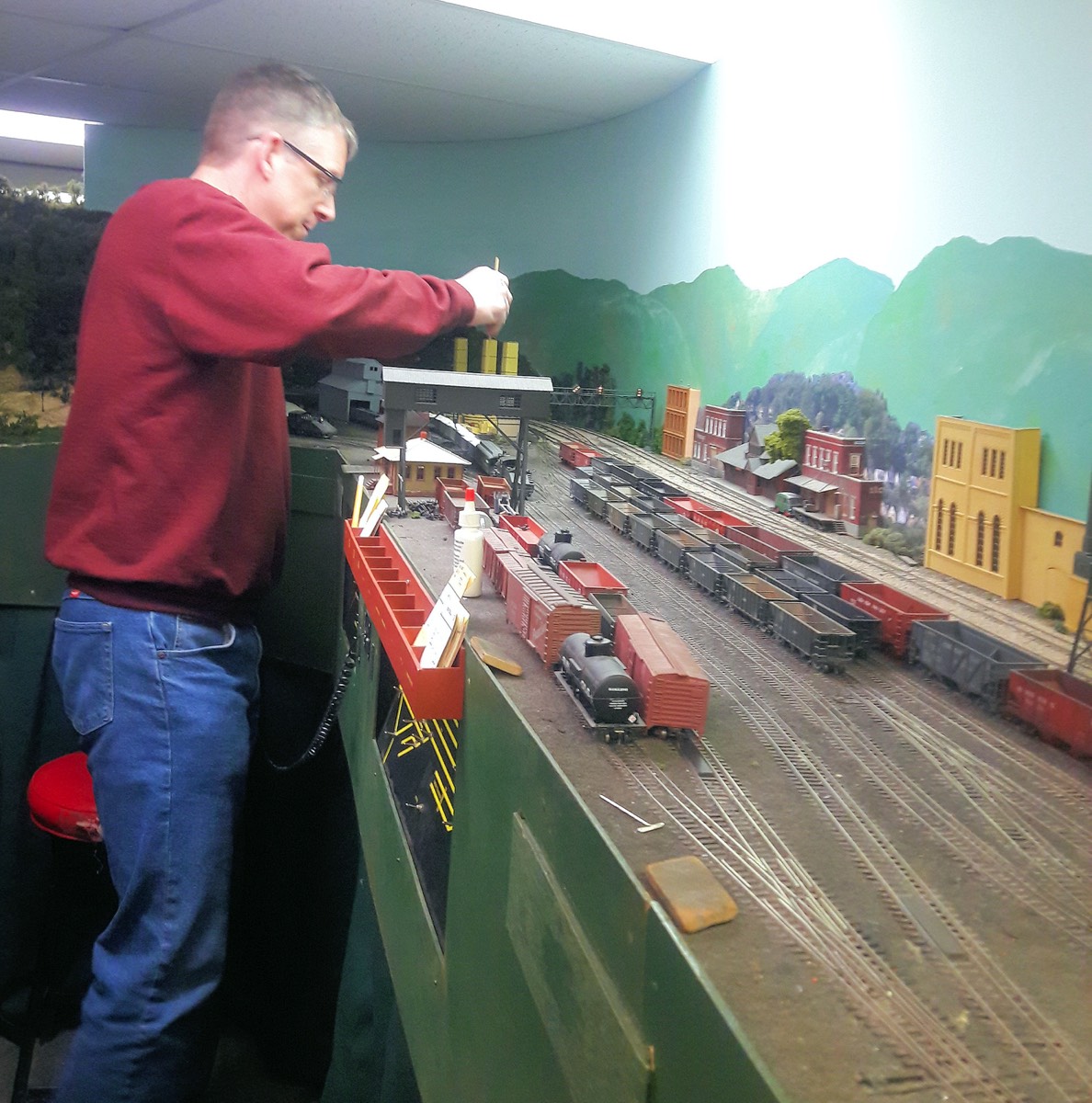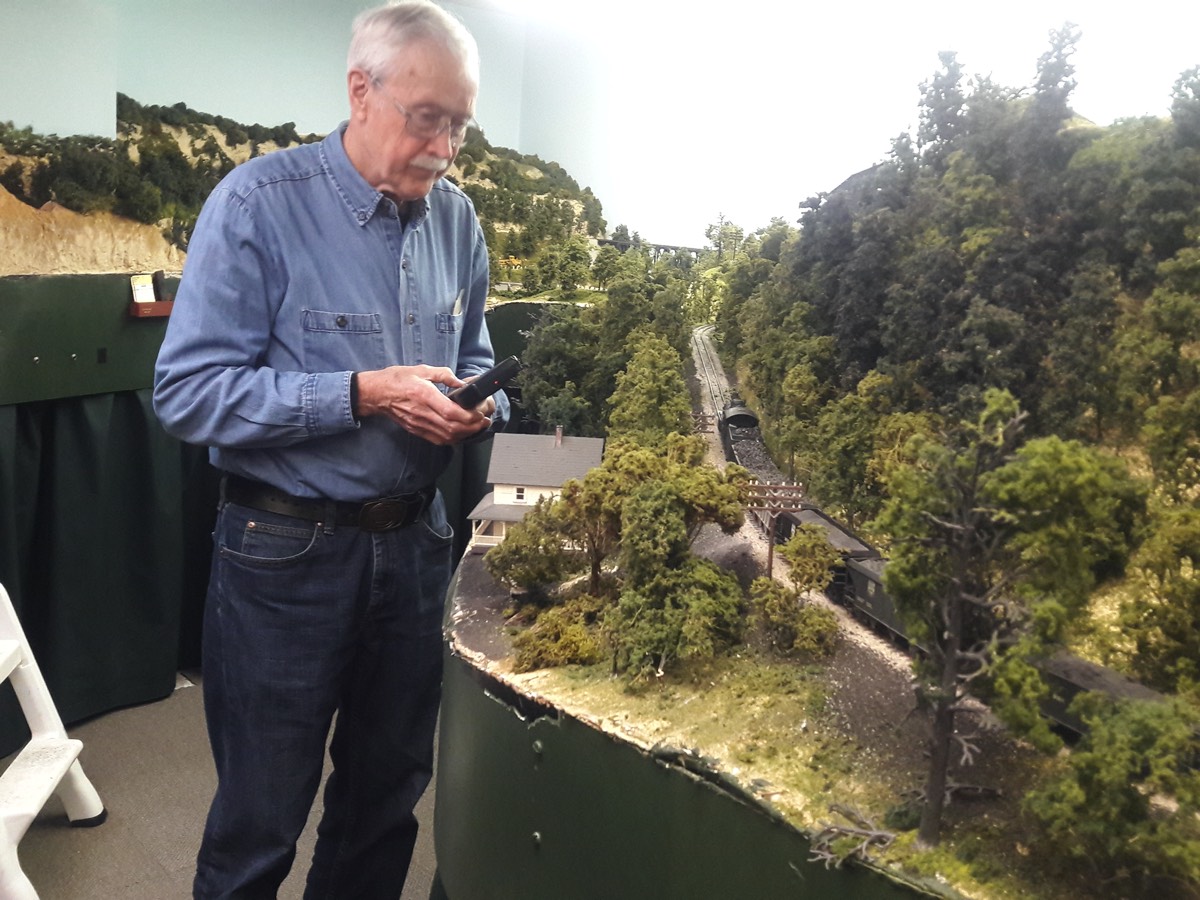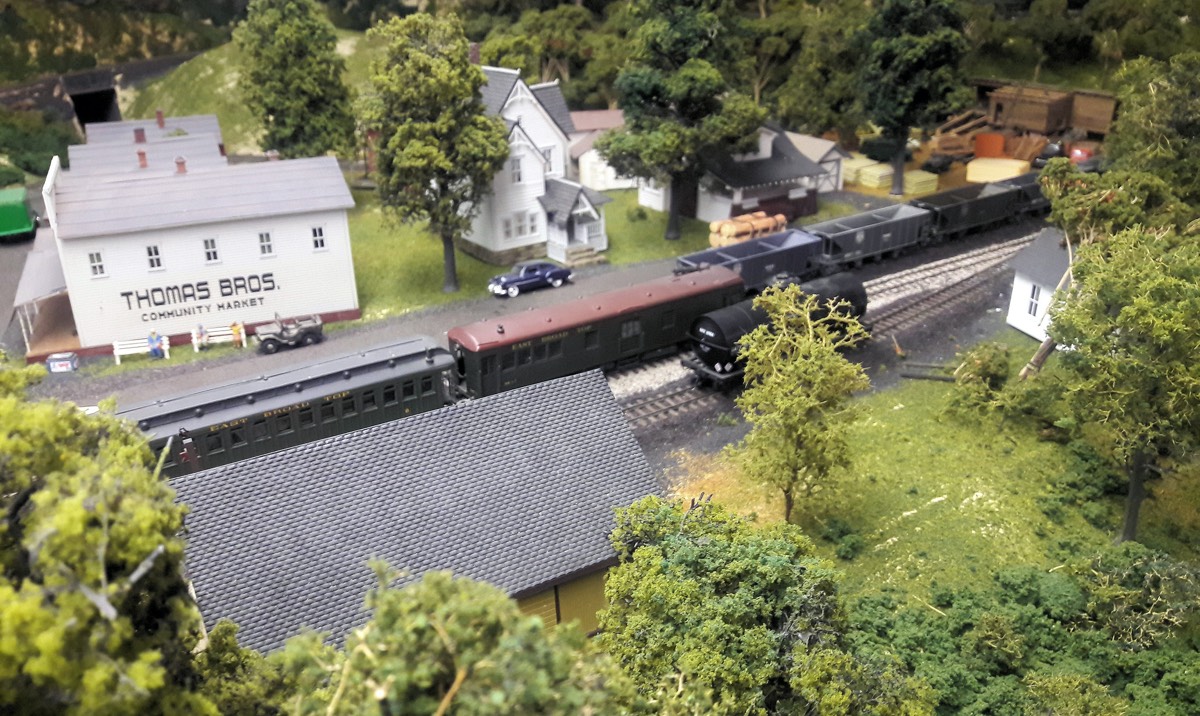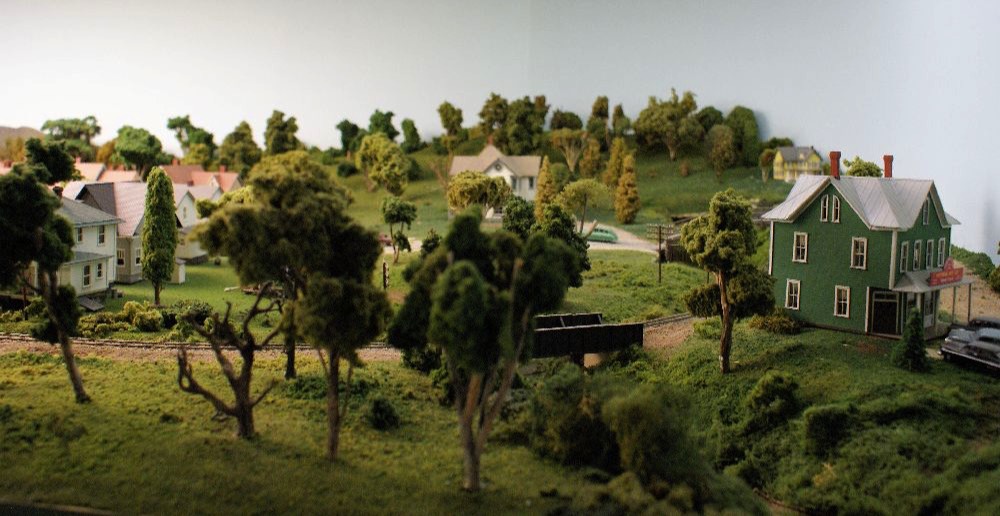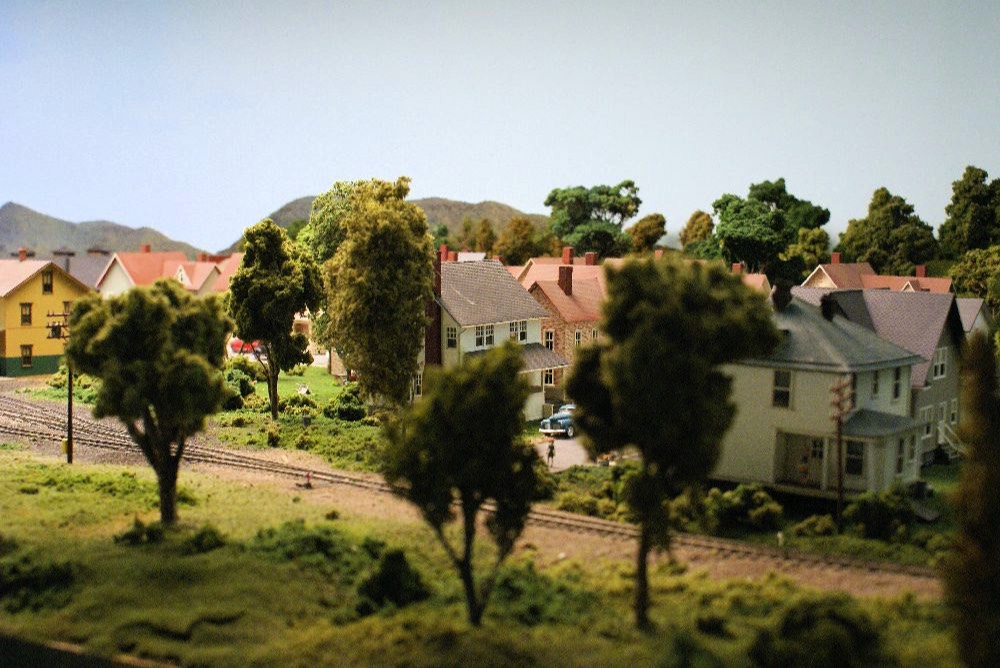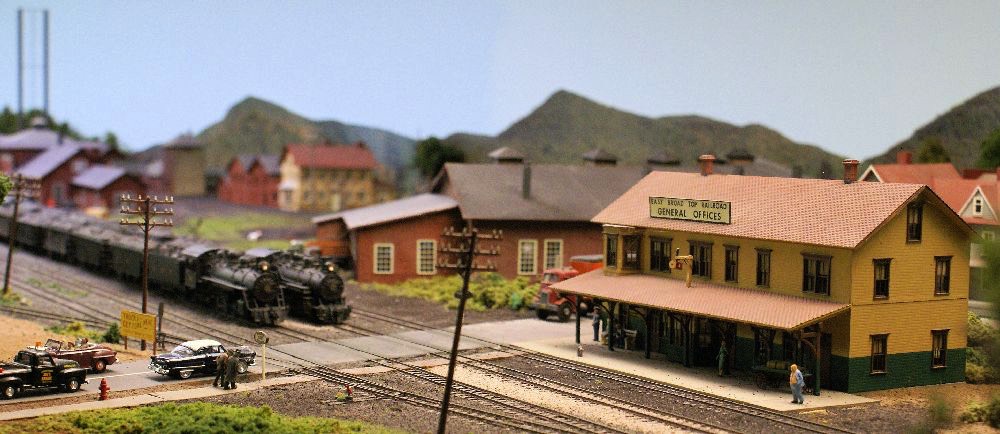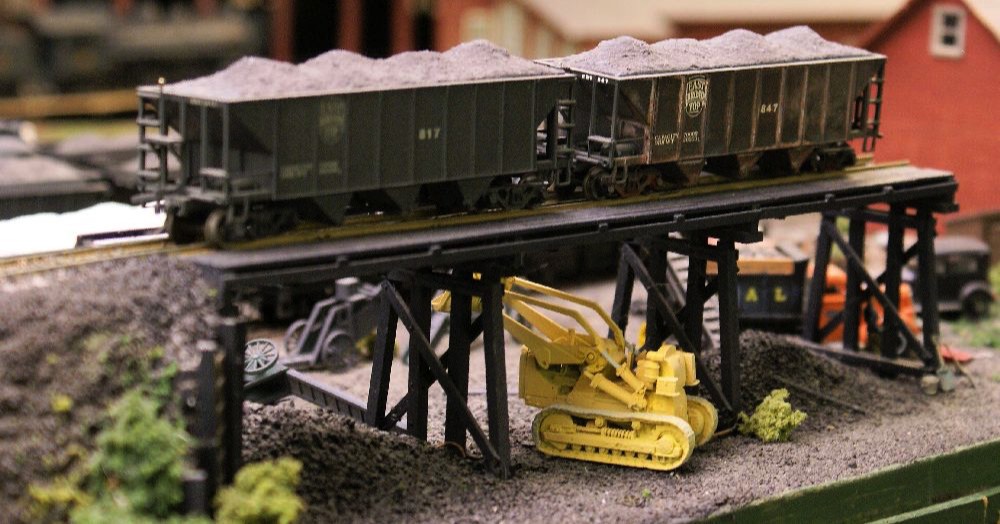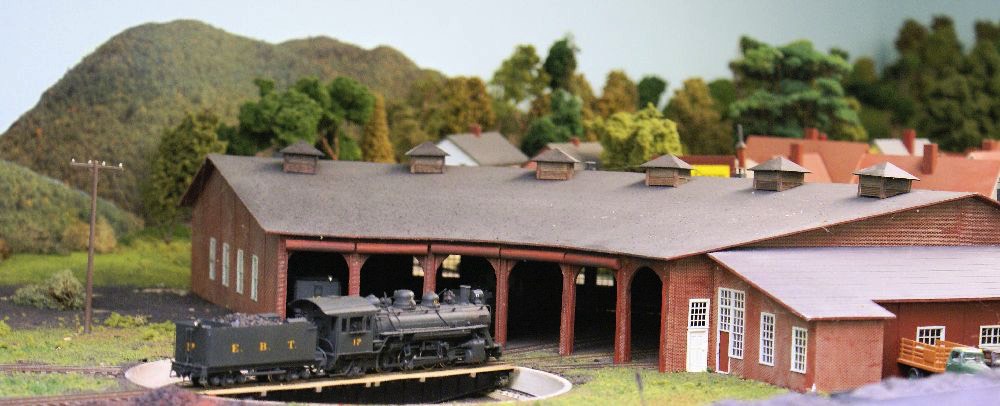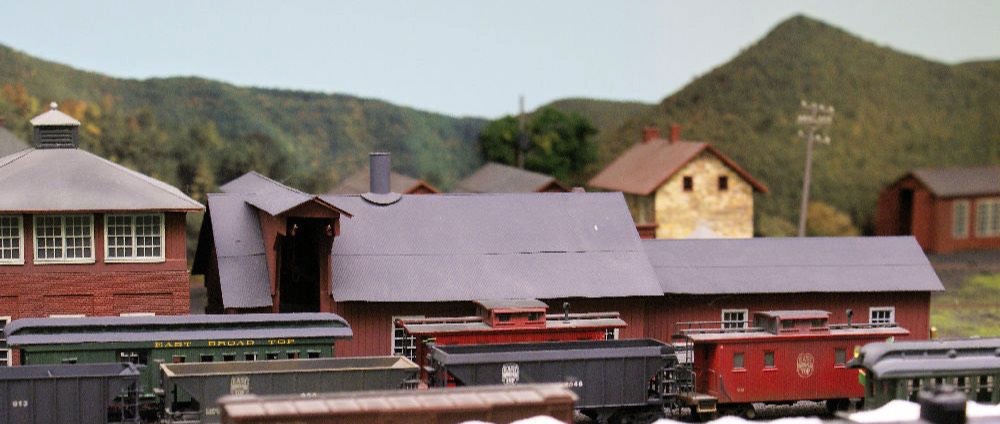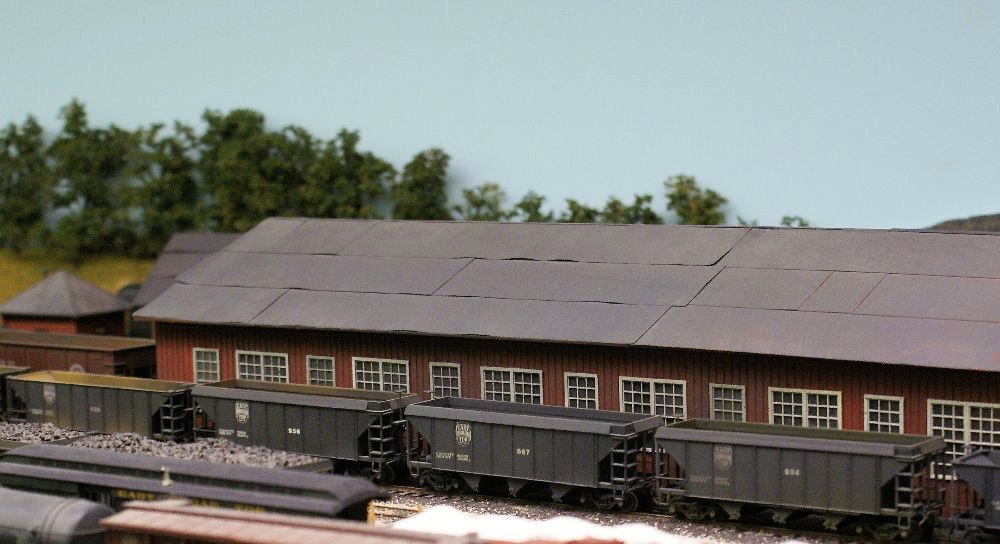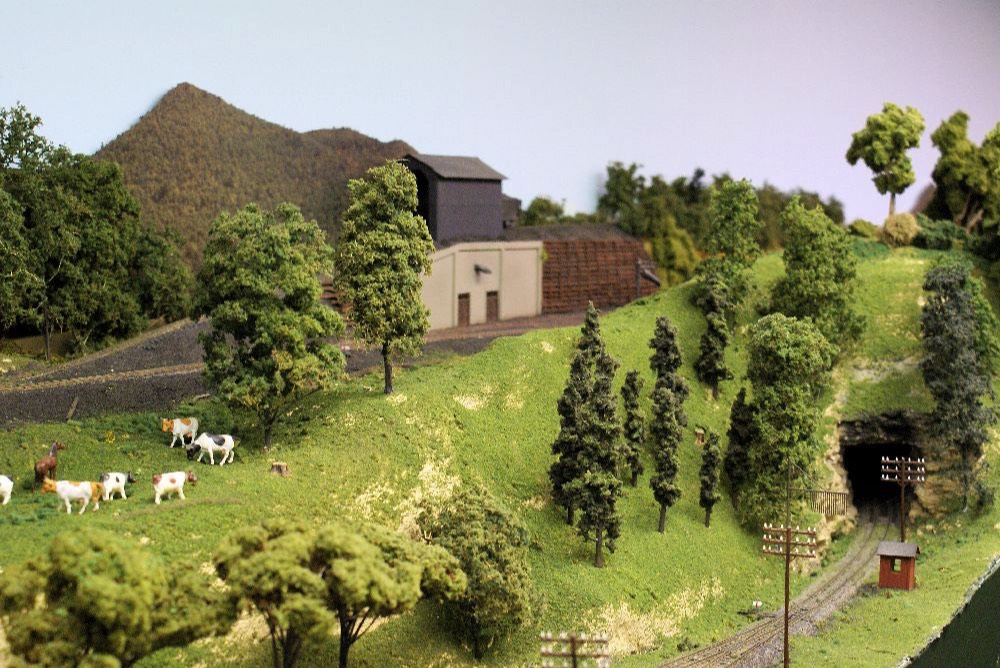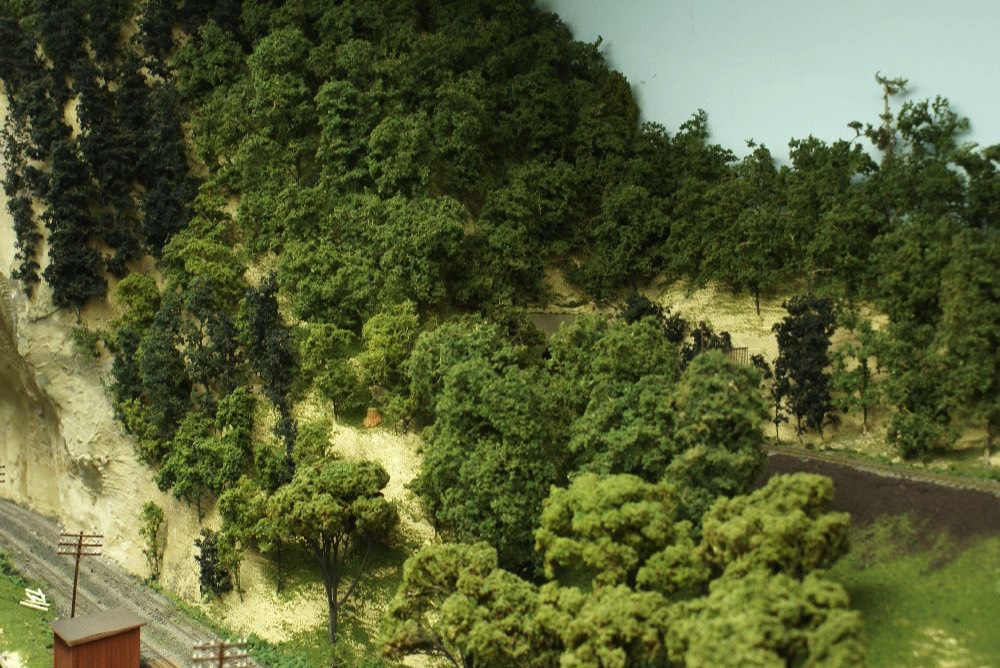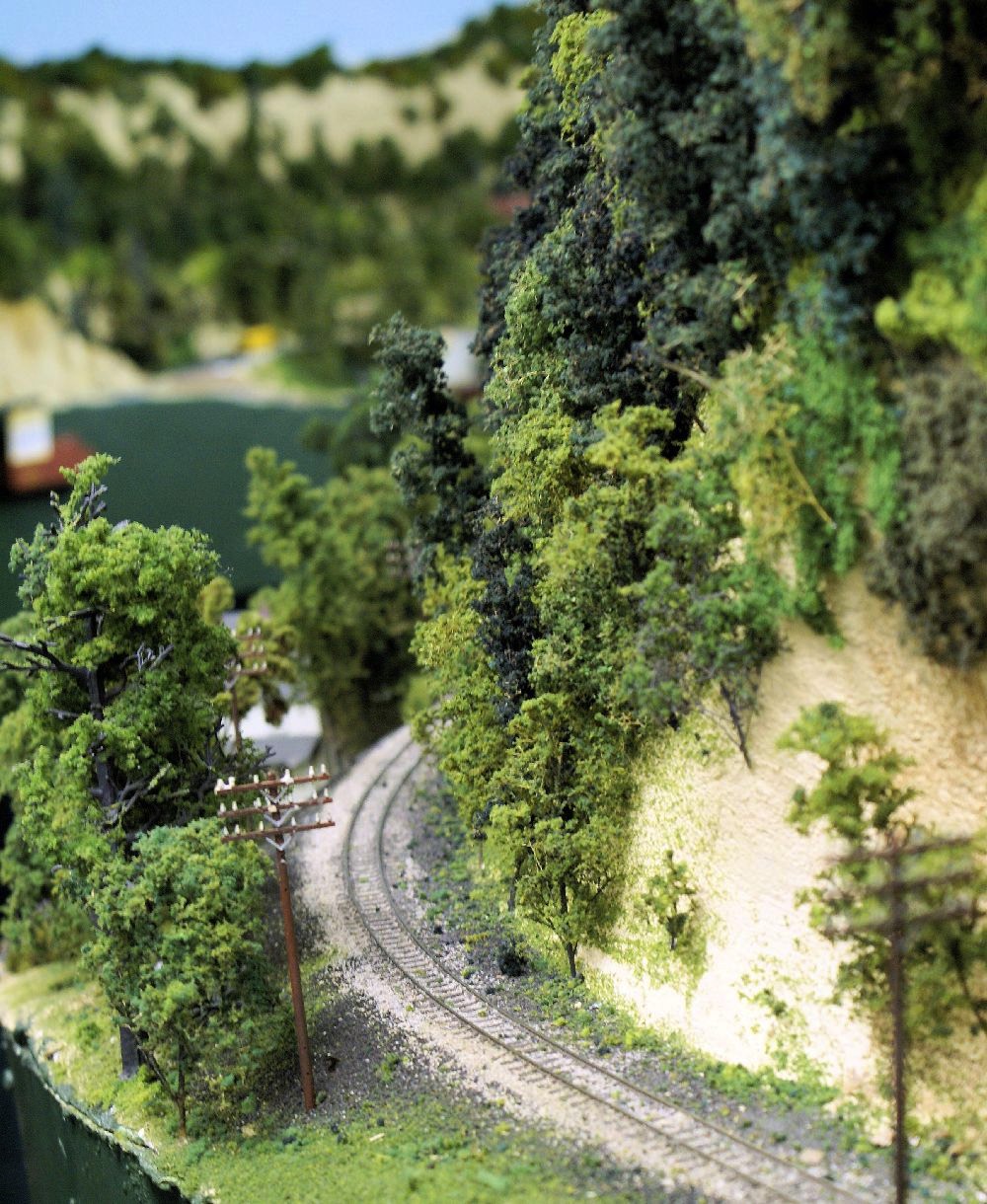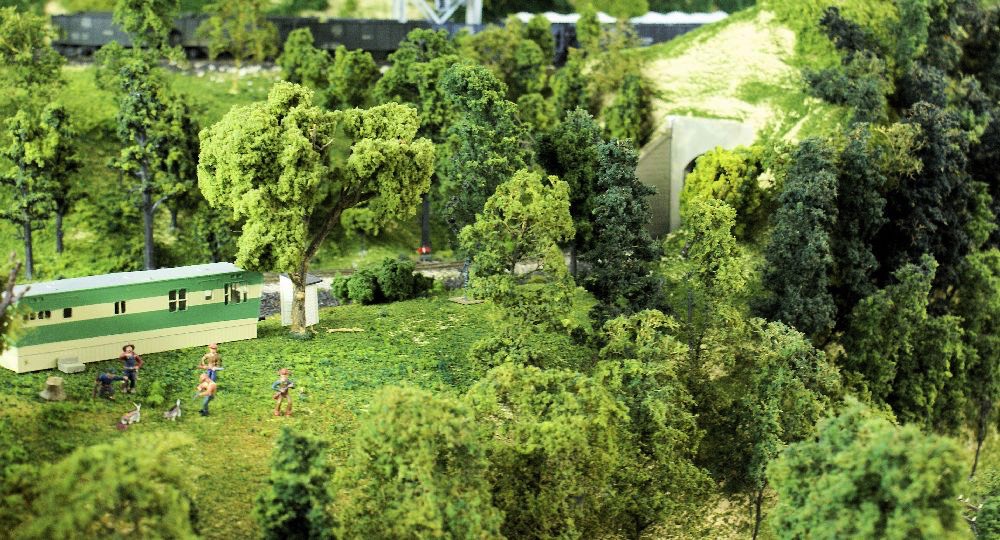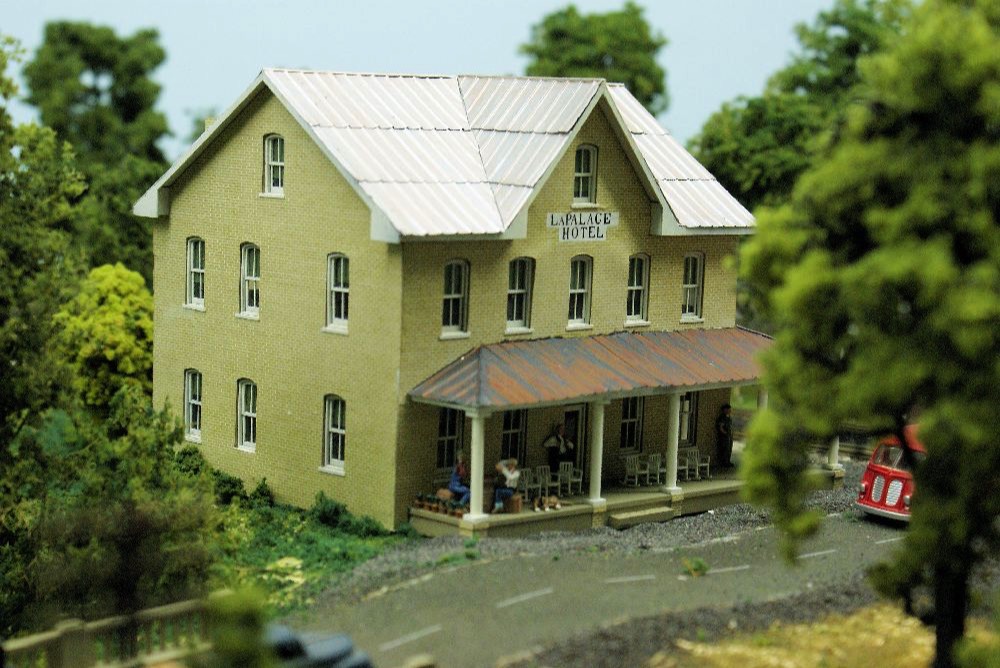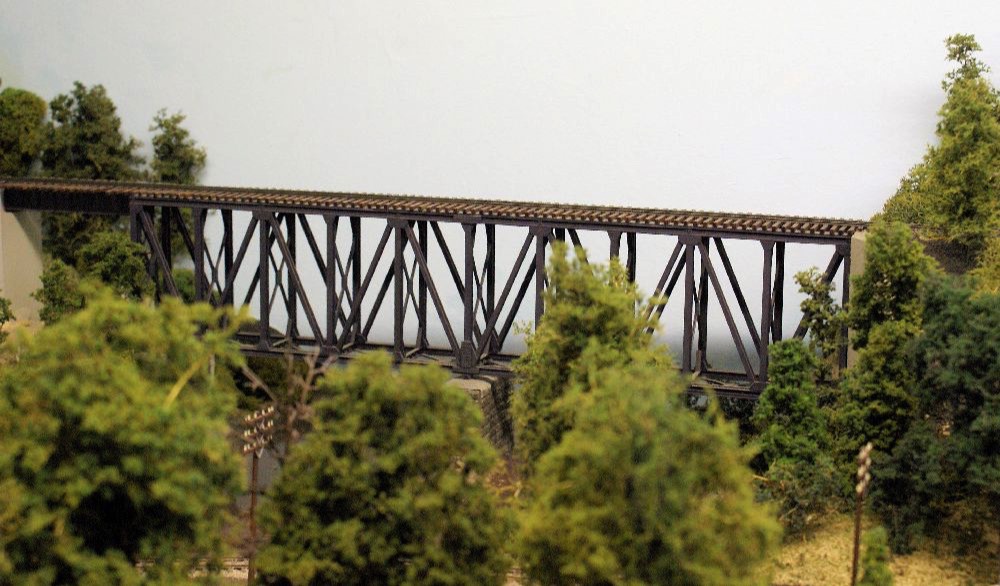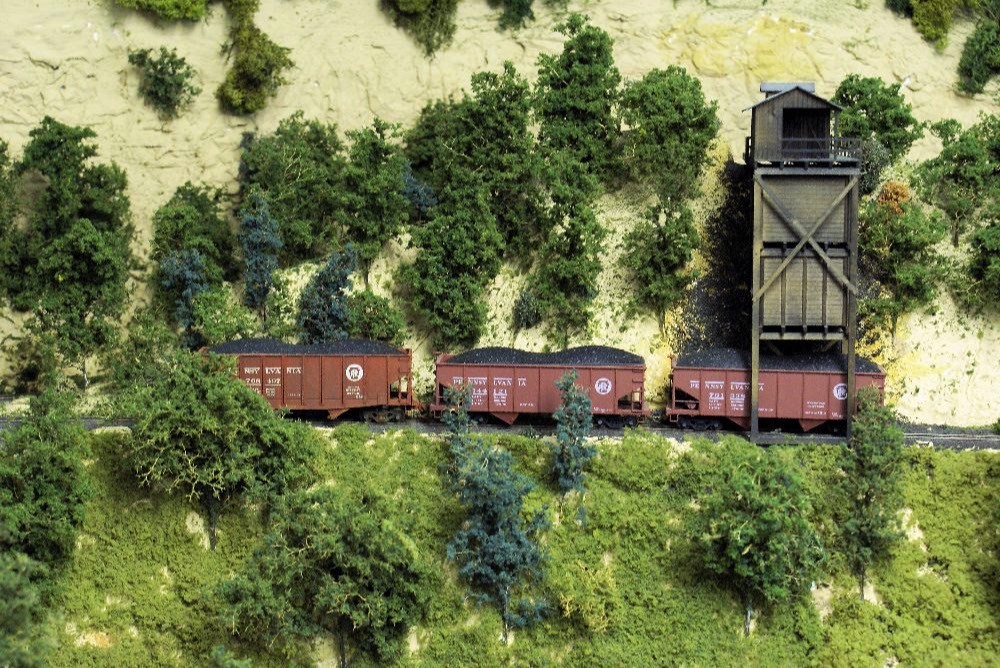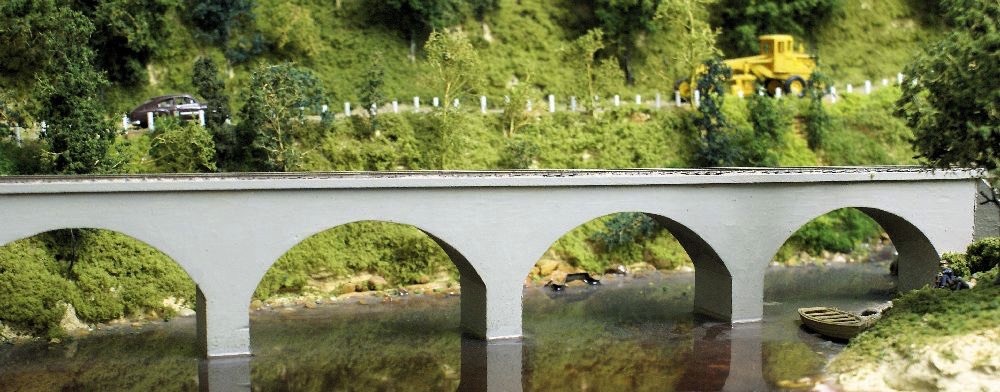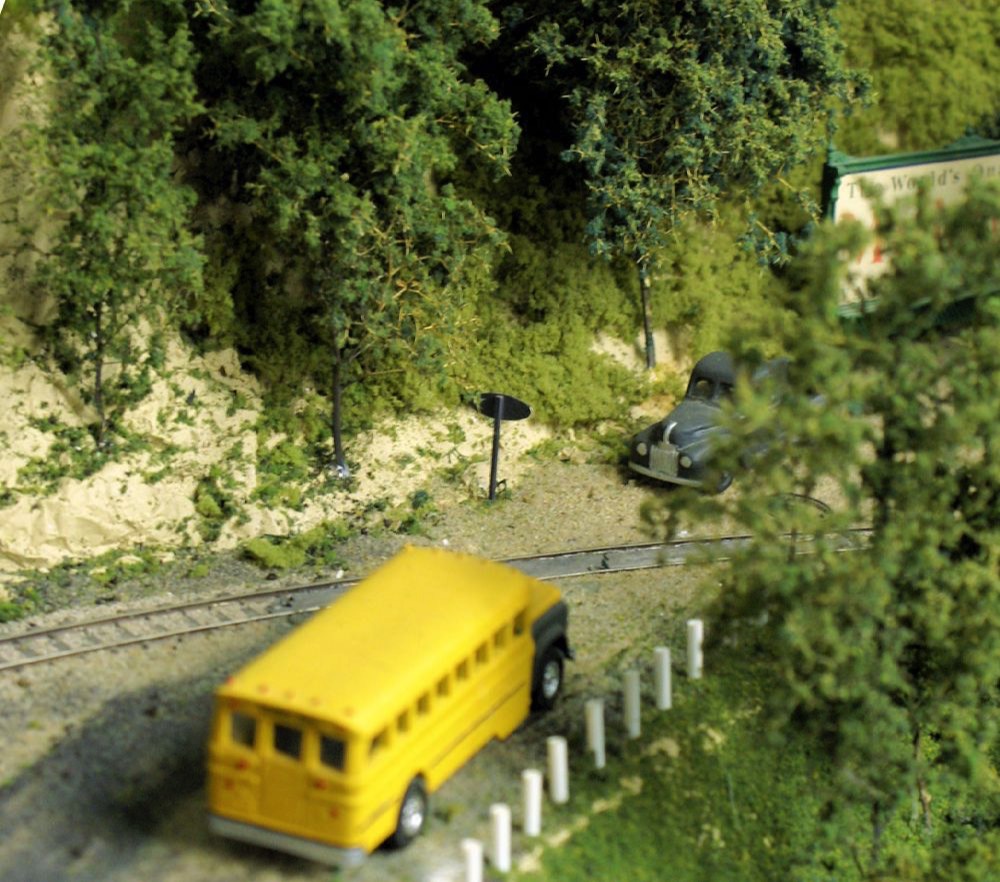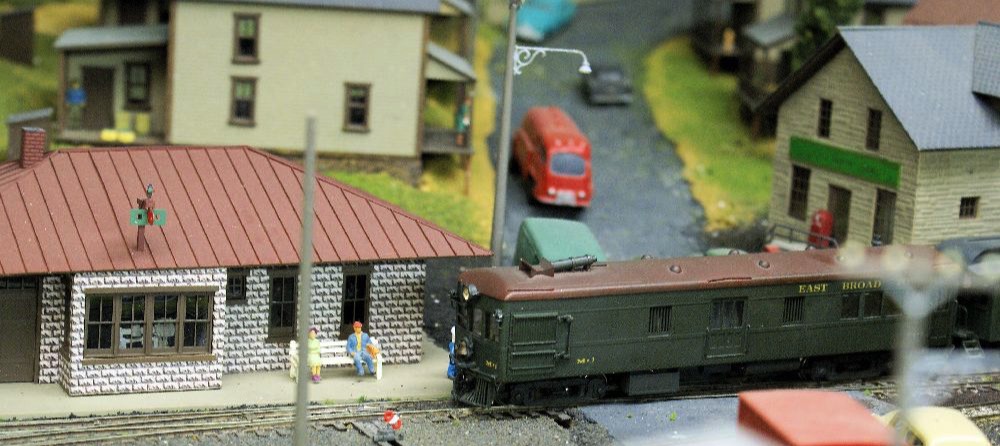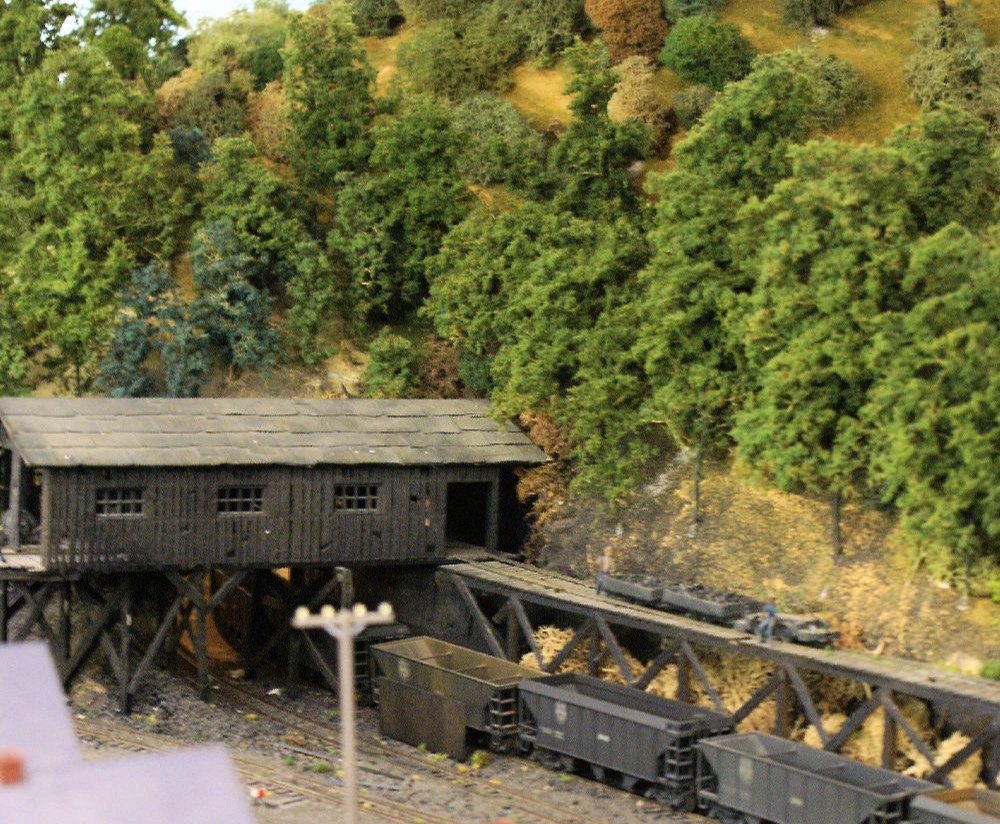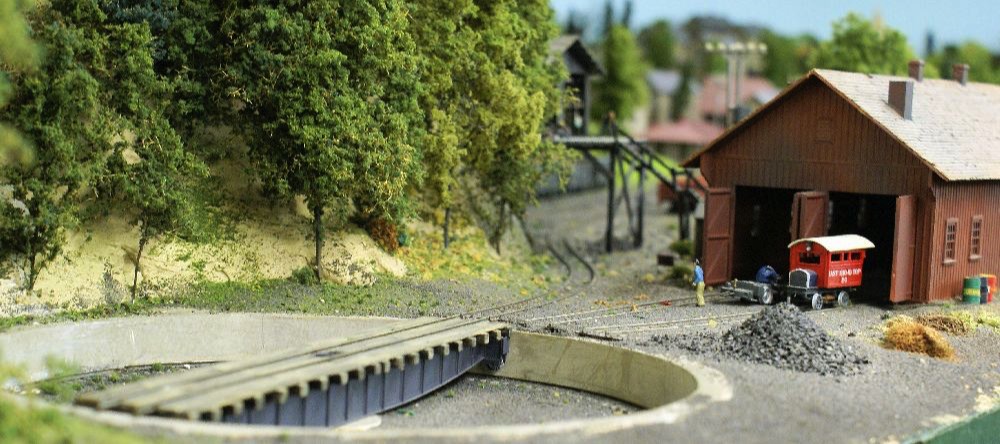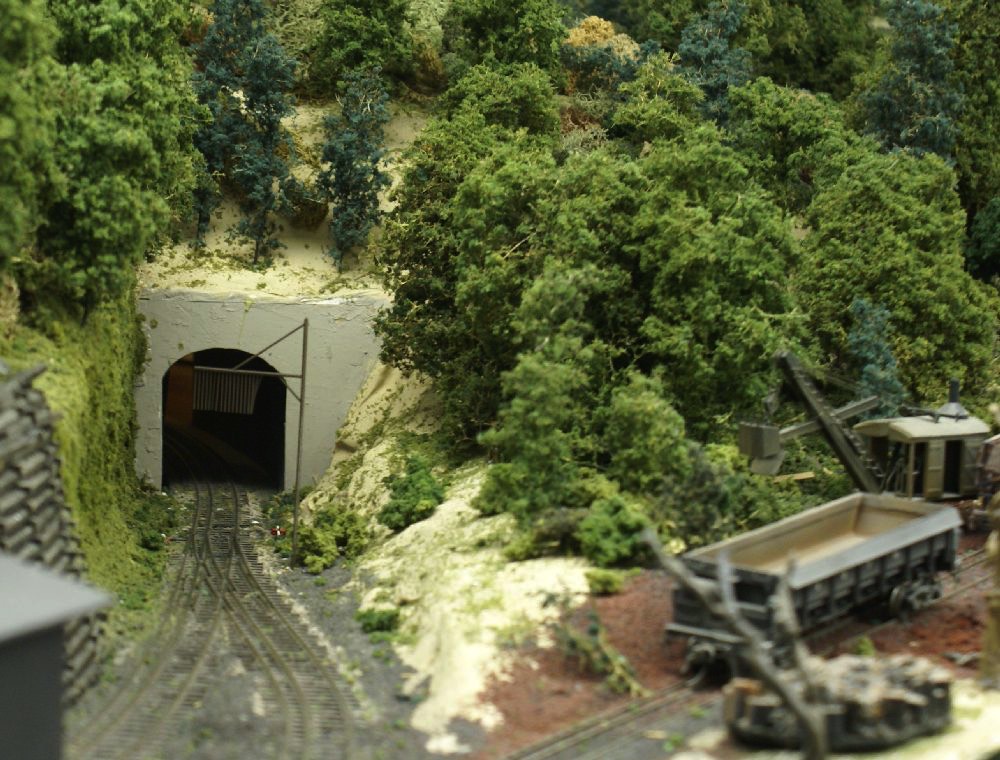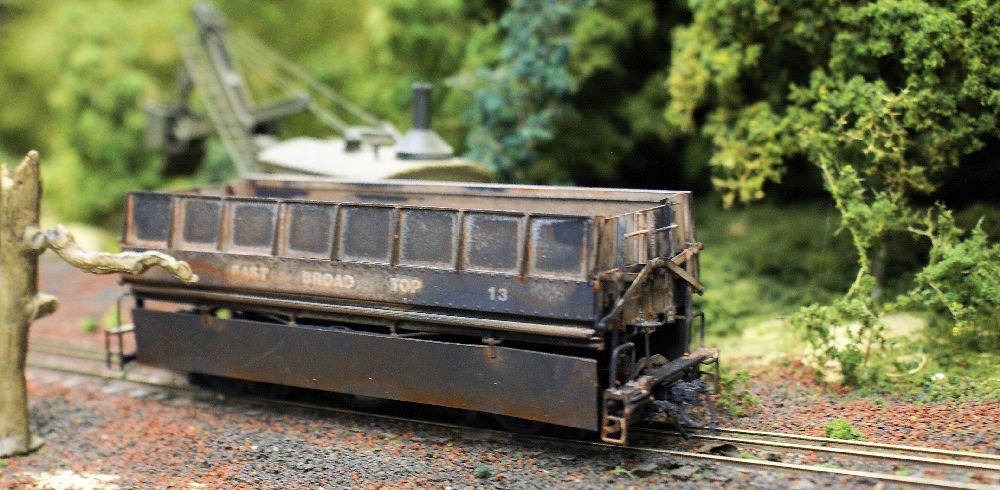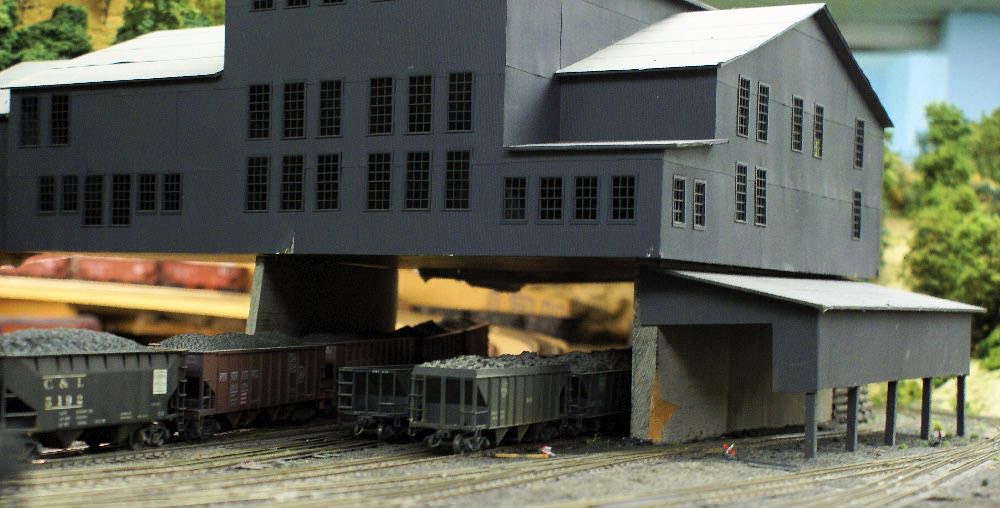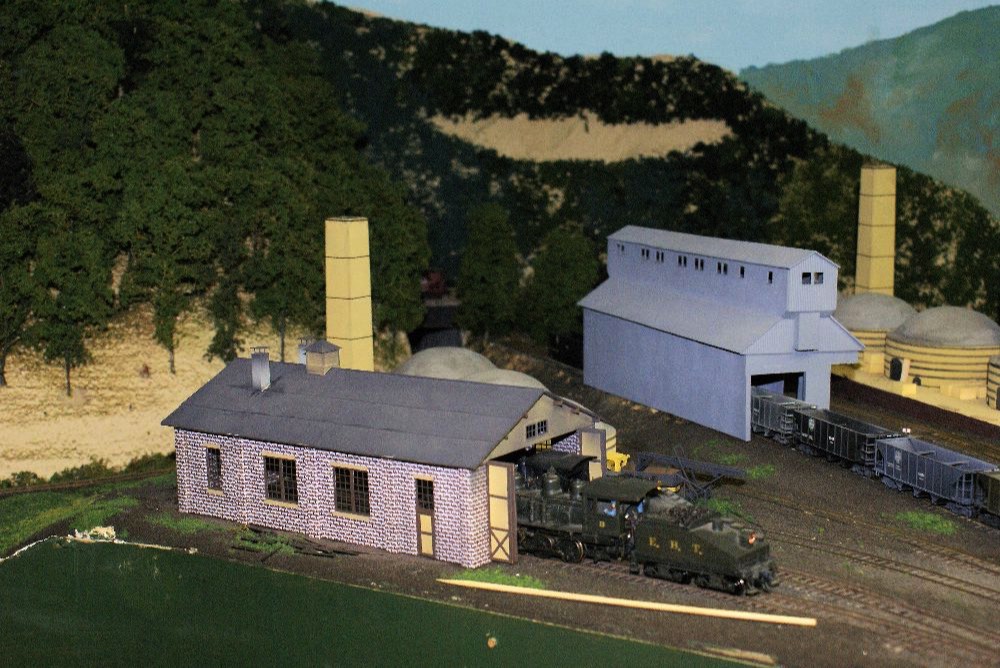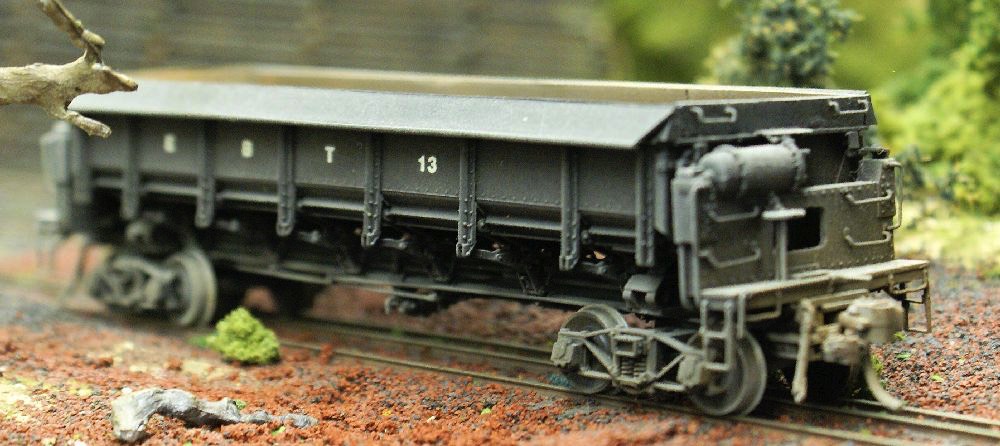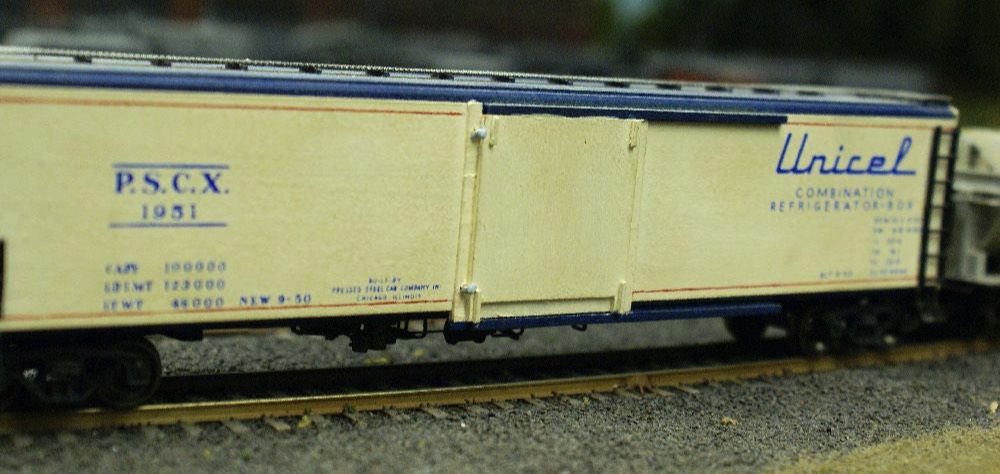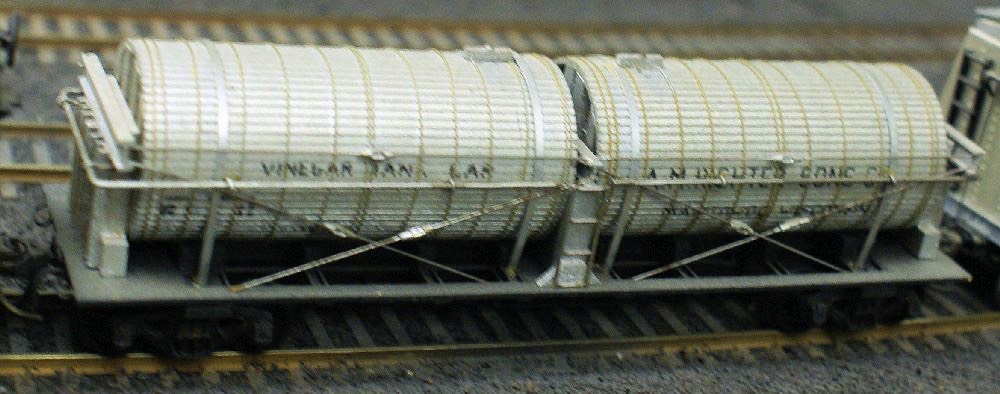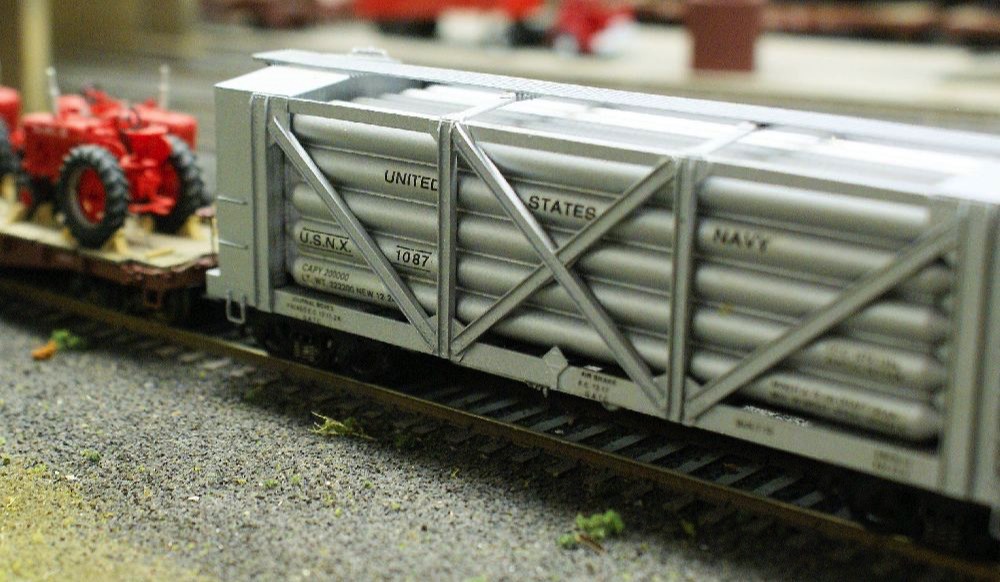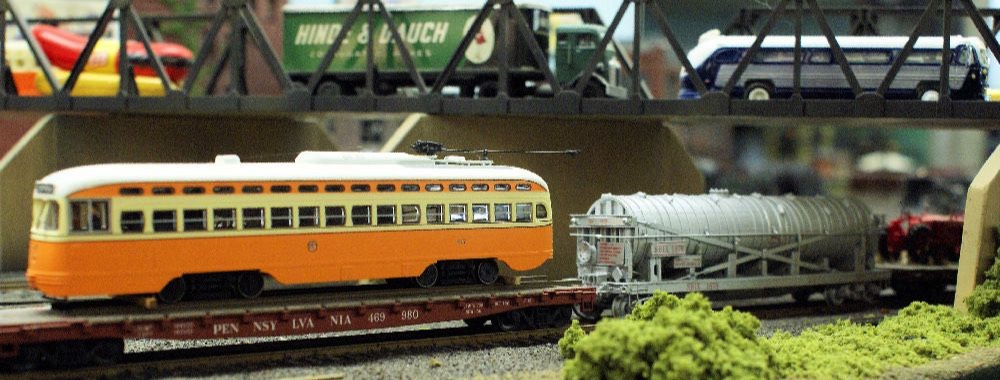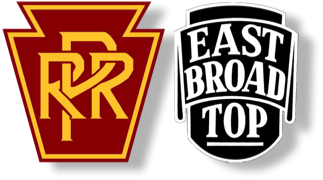
Doug Taylor’s Pennsylvania RR and East Broad Top

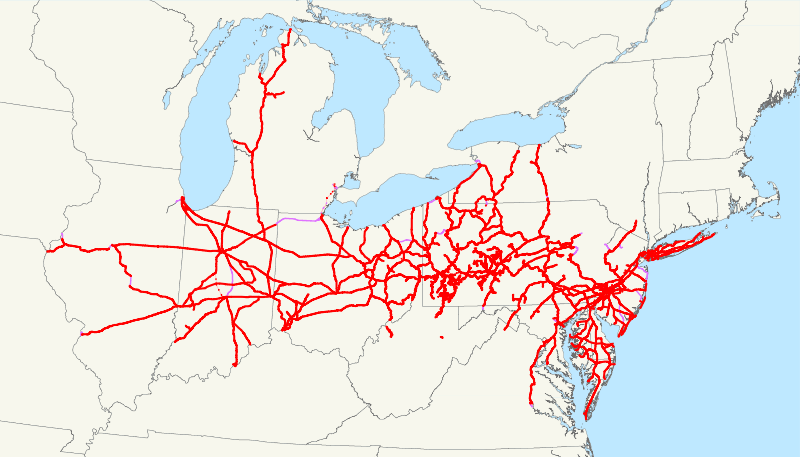
Pennsy system map
click to embiggen

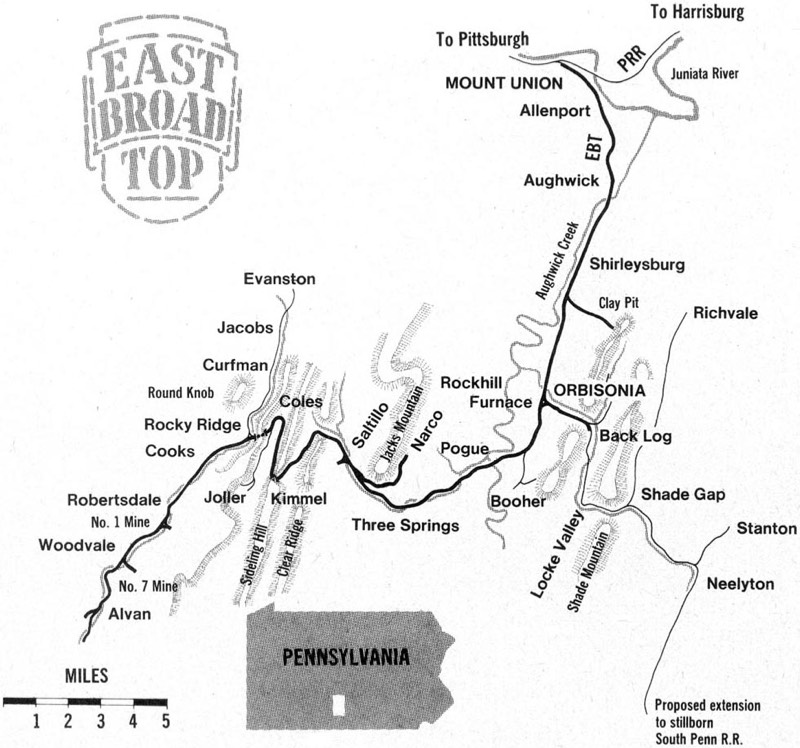
East Broad Top system map
click to embiggen
The East Broad Top Railroad is a HO 3 foot narrow gauge coal hauling railroad in South Central Pennsylvania. This modern, steam-powered railroad runs south from the dual gauge interchange with the Pennsylvania at Mount Union, through the shop and headquarters town of Orbisonia, the ganister rock quarry town of Saltillo, and terminates at the mines of Robertsdale.
The point-to-point EBT system features coal trains, rock trains, mixed freight, passenger and gas electric operations with modern steel equipment. Crew requirements are a dispatcher, Orbisonia yardmaster, Mount Union yardmaster, and 4 road crews. Communications is by vintage telephones.
The Pennsy Railroad is a fully separate, standard gauge HO layout that occupies a 36 ft by 48 ft portion of the basement. The design was adapted from a John Armstrong design and features legendary Pennsy scenic elements like the four-track Horseshoe Curve. The Pennsy is fully signaled with position-light signals.
The point-to-point EBT system features coal trains, rock trains, mixed freight, passenger and gas electric operations with modern steel equipment. Crew requirements are a dispatcher, Orbisonia yardmaster, Mount Union yardmaster, and 4 road crews. Communications is by vintage telephones.
The Pennsy Railroad is a fully separate, standard gauge HO layout that occupies a 36 ft by 48 ft portion of the basement. The design was adapted from a John Armstrong design and features legendary Pennsy scenic elements like the four-track Horseshoe Curve. The Pennsy is fully signaled with position-light signals.
This Layout was featured in the June 2018 issue of Railroad Model Craftsman*
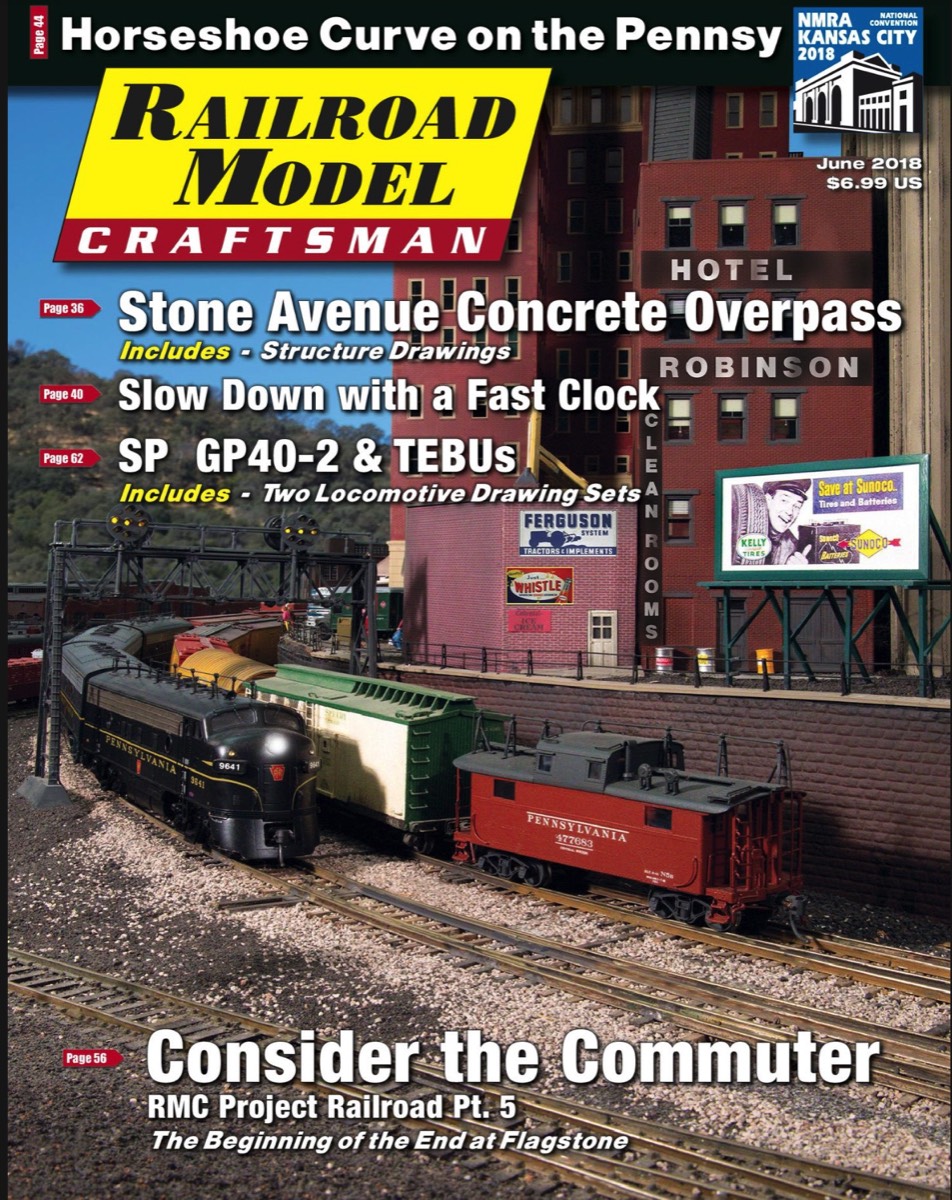
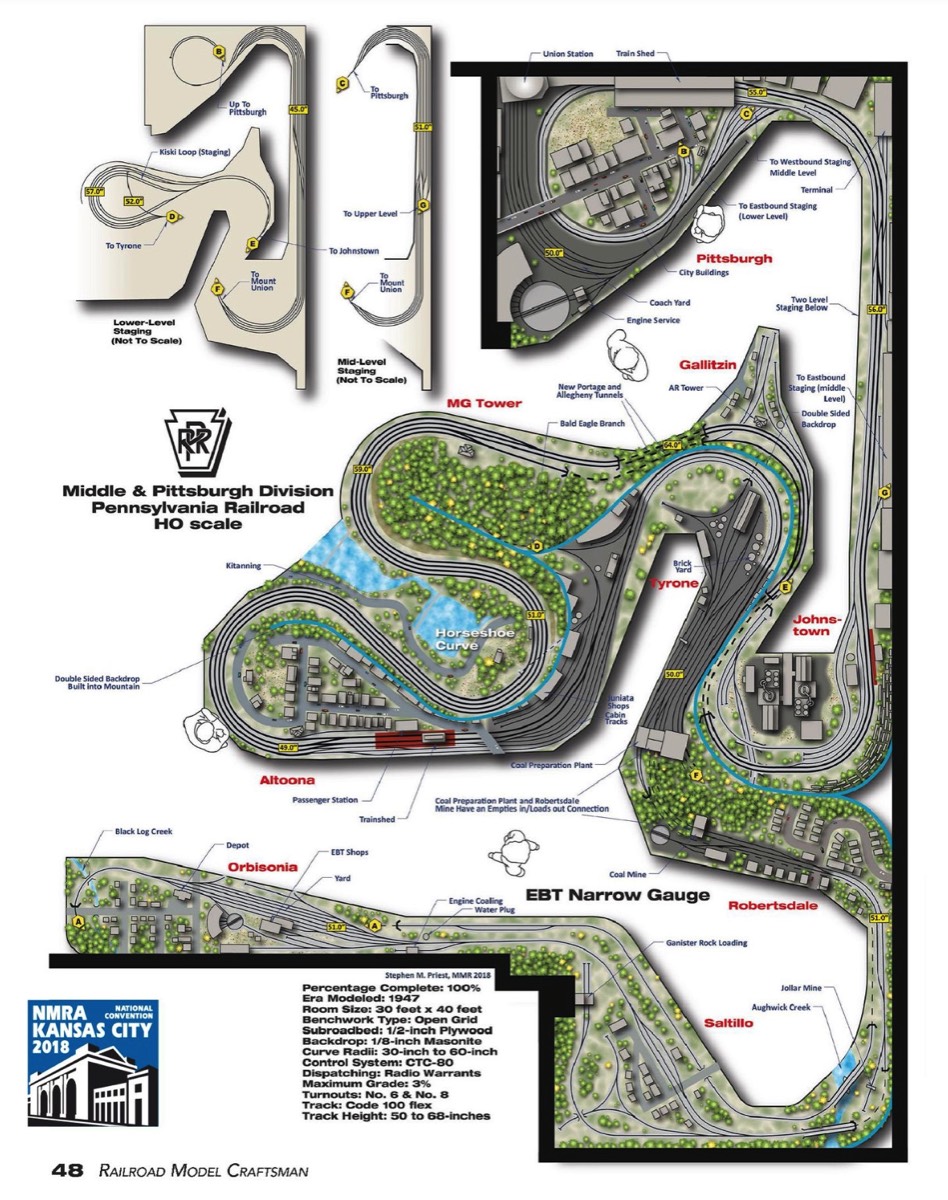
* Permission to use images obtained by publisher
Layout Accessibility Information

Entrance to the Pennsy and EBT layouts are via stairs with a hand rail to the basement
Layout at a Glance
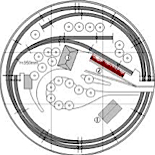
Layout at a glance
- Eastern Pennsylvania
- HOn3 (EBT) and HO (Pennsy)
- Circa 1949
- NCE (EBT) and CTC80 (Pennsy)
- Tsunami sound
- Scale Clock Speed: 4:1
- Length of Session: 12 fast hours
- 7 operators on the EBT / 10 operators on the Pennsy
- Timetable and train order
- Telephones
About the Layout Owner

About the layout owner
Doug Taylor, MMR #106
Grand Master Model Railroader #3, having earned ALL available Achievement Certificates.
Trains have always been a part of Doug's life. In the early 1940's, he often had cab rides on Pennsy L-1's while accompanying his train-loving mother in Philipsburg, PA. Her Doctor's office was close to the tracks.
Doug was given his first Lionel train at Christmas of 1944. He kept modeling with Lionel, until he went to Dartmouth College and switched to HO. Graduate school at Yale School of Drama also offered a membership in the old New Haven Society of Engineers. This resulted in modeling friendships that lasted for many years and opened his modeling horizons.
During his college years, Doug spent summers working for the famed Mount Washington Cog Railway in New Hampshire. He started as a Brakeman/Conductor, became a Fireman (shoveling a ton of coal each trip up the mountain) and ultimately an Engineer (on a 1895 steam engine). Because he built models at night, he was placed in charge of the Carshops, where he and his men (John and Jeffrey) built a modern Aluminum passenger car, seating 56 people, and then instituted a major rehab program on the six-car fleet of wooden passenger cars, several of which dated back to the 1880’s.
After earning his Master of Fine Arts from Yale, Doug taught at number of colleges and universities. Doug retired from the University of Missouri at Kansas City, where he headed a Top 10 Graduate Program in Theatre Technology. Doug was also the Technical Production Director for the University and the professional Missouri Repertory Theater for 30 years. He is proud to have introduced modern materials to scenic construction, and to have achieved professional status for theatrical technicians.
Now long retired, he spends his time with his wife, Missy, basset hounds and dog show judging, and model railroading.
Grand Master Model Railroader #3, having earned ALL available Achievement Certificates.
Trains have always been a part of Doug's life. In the early 1940's, he often had cab rides on Pennsy L-1's while accompanying his train-loving mother in Philipsburg, PA. Her Doctor's office was close to the tracks.
Doug was given his first Lionel train at Christmas of 1944. He kept modeling with Lionel, until he went to Dartmouth College and switched to HO. Graduate school at Yale School of Drama also offered a membership in the old New Haven Society of Engineers. This resulted in modeling friendships that lasted for many years and opened his modeling horizons.
During his college years, Doug spent summers working for the famed Mount Washington Cog Railway in New Hampshire. He started as a Brakeman/Conductor, became a Fireman (shoveling a ton of coal each trip up the mountain) and ultimately an Engineer (on a 1895 steam engine). Because he built models at night, he was placed in charge of the Carshops, where he and his men (John and Jeffrey) built a modern Aluminum passenger car, seating 56 people, and then instituted a major rehab program on the six-car fleet of wooden passenger cars, several of which dated back to the 1880’s.
After earning his Master of Fine Arts from Yale, Doug taught at number of colleges and universities. Doug retired from the University of Missouri at Kansas City, where he headed a Top 10 Graduate Program in Theatre Technology. Doug was also the Technical Production Director for the University and the professional Missouri Repertory Theater for 30 years. He is proud to have introduced modern materials to scenic construction, and to have achieved professional status for theatrical technicians.
Now long retired, he spends his time with his wife, Missy, basset hounds and dog show judging, and model railroading.
East Broad Top Railroad
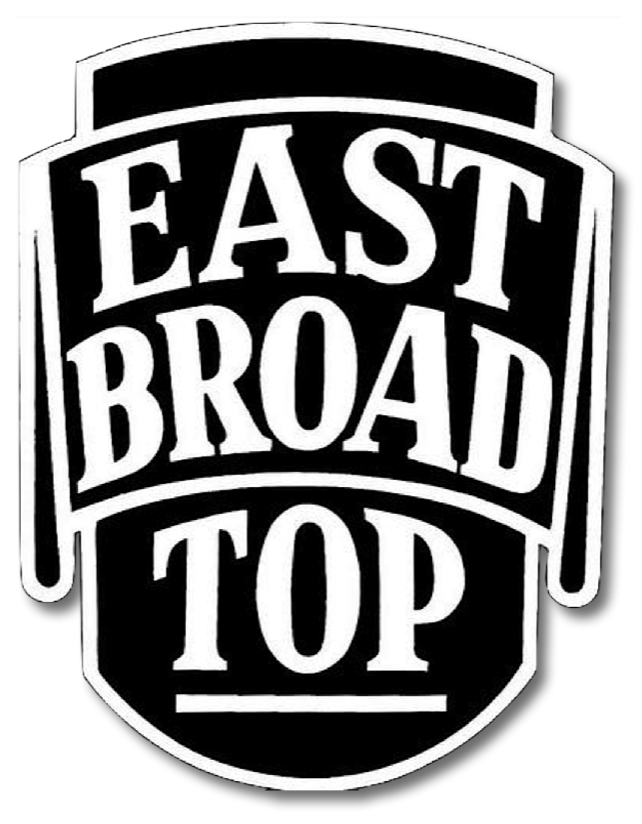
Overview of the East Broad Top Railroad
Construction of the EBT started when I built the original Orbisonia section (with roundhouse, station and shops) in my stage scenery shop three months before we took possession of the house in March of 1979. The section was part of a layout plan designed by the late, great John Armstrong. Once it was wedged down the cellar stairs and bolted to the wall, the railroad grew from there. By Thanksgiving all track was in, and after a turntable was operational at Robertsdale (my end of the line), operations began in late February, on a true point to point railroad..
The railroad physically starts at Mount Union, PA with a three-rail yard interchanging with the standard guage Pennsylvania Railroad. Since this is the start of the EBT, there is a wye for turning engines, and the hulking coal cleaning plant. Incoming trains switch loaded hopper cars into the plant, and empty hoppers are pulled out to make up the South bound trains. Pennsy hoppers also are worked here. Standard gauge cars are shifted to the Timber Transfer where they are equipped with narrow gauge trucks to run to various destinations on the EBT.
The narrow gauge trains leave Mount Union through the Southbound tunnel. After exiting from the tunnel, they cross the concrete arch Auwick Creek bridge, climb over the first hill, pass the Hernial Mountain, and enter the passing siding at Shirlysburg (orders may be taken by vintage phone system there). After clearance from the dispatcher, the trains enter a long tunnel and appear on the northern edges of Orbisonia.
At Orbisonia, the EBT has its shops, roundhouse and yard. Some switching may occur here. When that is completed, the train will keep working its way South, passing through the Sidling Hill Tunnel, and perhaps dropping a car or two at Saltillo, PA. At Saltillo, a 4 percent steep branch goes up the side of the mountain to the Gannister Rock Loader. Empty rock cars are pushed up head of the engine in groups of four to the loader and exchanged with loads. Special rock trains are assigned to this task.
After crossing the high Pogue deck girder bridge, the train terminates at Robertsdale, PA, a company town. Here the engine is cut off, and runs around its train to push the empty hoppers into the coal mine. Other loads may be shifted to the team track. The engine drops its waycar in the clear, and runs to the turntable, is turned, and returns to the yard to pull eleven loaded hopper cars from the mine. Misc. other freight cars are added as needed, the train is put back together, and waits for the Dispatcher in Orbisonia to tell it to head back North, probably meeting several other trains.
Originally, the EBT was powered with two Dynotrol (remember those?) cabs. In 1984, the EBT was converted to CTC32, and then to CTC80. Now we could have 4 or 5 narrow gauge trains in operation at once. Two years ago we updated with a digital Northcoast system with sound which greatly helped with its audio realism. Six throttles are currently used.
The EBT rosters 6 narrow gauge Mike 2-8-2's, a gas-electric, a 1928 Nash railcar, and two standard gauge 0-6-0's. These pull 110 hopper cars, 8 boxcars, 8 flats, 1 tank car, and 1 scale test car. You will also find 10 passenger cars and two cabooses. Standard gauge cars on narrow gauge trucks vary in number.
The EBT will hire a Dispatcher who knows how to write train orders, 2 coal train crews, 1 rock crew, & 1 passenger crew who can run either steam or gas-electric. A critical position is the yard master at Mount Union, and an easier yard job at Orbisonia. It is a busy little railroad.
Come and think narrow.
The railroad physically starts at Mount Union, PA with a three-rail yard interchanging with the standard guage Pennsylvania Railroad. Since this is the start of the EBT, there is a wye for turning engines, and the hulking coal cleaning plant. Incoming trains switch loaded hopper cars into the plant, and empty hoppers are pulled out to make up the South bound trains. Pennsy hoppers also are worked here. Standard gauge cars are shifted to the Timber Transfer where they are equipped with narrow gauge trucks to run to various destinations on the EBT.
The narrow gauge trains leave Mount Union through the Southbound tunnel. After exiting from the tunnel, they cross the concrete arch Auwick Creek bridge, climb over the first hill, pass the Hernial Mountain, and enter the passing siding at Shirlysburg (orders may be taken by vintage phone system there). After clearance from the dispatcher, the trains enter a long tunnel and appear on the northern edges of Orbisonia.
At Orbisonia, the EBT has its shops, roundhouse and yard. Some switching may occur here. When that is completed, the train will keep working its way South, passing through the Sidling Hill Tunnel, and perhaps dropping a car or two at Saltillo, PA. At Saltillo, a 4 percent steep branch goes up the side of the mountain to the Gannister Rock Loader. Empty rock cars are pushed up head of the engine in groups of four to the loader and exchanged with loads. Special rock trains are assigned to this task.
After crossing the high Pogue deck girder bridge, the train terminates at Robertsdale, PA, a company town. Here the engine is cut off, and runs around its train to push the empty hoppers into the coal mine. Other loads may be shifted to the team track. The engine drops its waycar in the clear, and runs to the turntable, is turned, and returns to the yard to pull eleven loaded hopper cars from the mine. Misc. other freight cars are added as needed, the train is put back together, and waits for the Dispatcher in Orbisonia to tell it to head back North, probably meeting several other trains.
Originally, the EBT was powered with two Dynotrol (remember those?) cabs. In 1984, the EBT was converted to CTC32, and then to CTC80. Now we could have 4 or 5 narrow gauge trains in operation at once. Two years ago we updated with a digital Northcoast system with sound which greatly helped with its audio realism. Six throttles are currently used.
The EBT rosters 6 narrow gauge Mike 2-8-2's, a gas-electric, a 1928 Nash railcar, and two standard gauge 0-6-0's. These pull 110 hopper cars, 8 boxcars, 8 flats, 1 tank car, and 1 scale test car. You will also find 10 passenger cars and two cabooses. Standard gauge cars on narrow gauge trucks vary in number.
The EBT will hire a Dispatcher who knows how to write train orders, 2 coal train crews, 1 rock crew, & 1 passenger crew who can run either steam or gas-electric. A critical position is the yard master at Mount Union, and an easier yard job at Orbisonia. It is a busy little railroad.
Come and think narrow.
Pennsylvania Railroad
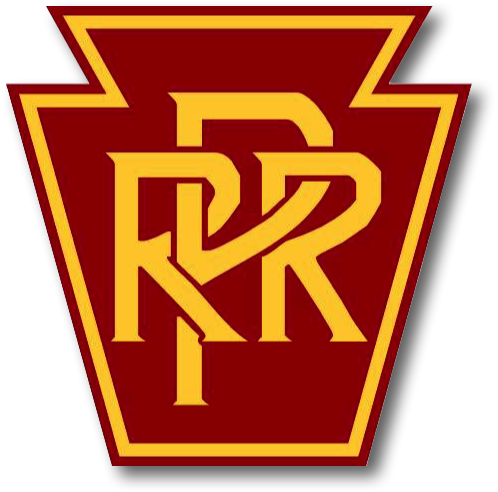
Overview of the Pennsylvania Railroad
The Penny occupies a 36' x 48' basement along with the East Broad Top. The design was commissioned by the late, great layout and operations planner, John Armstrong for my house in Ithica, NY. A sudden move meant that the plan was adapted for our new basement..
From East to West, the railroad runs from staging to Mount Union, PA, quickly passes the wye at Tyrone (wihich starts the Bald Eagle branch), and pauses at Altoona, PA, home of a yard and the railroad's shops. Here, almost every train gets helper engines, or "Snappers" in Pennsy lingo. Passenger trains get head end power added, and freights have a variety of engines added behind their strong cabooses, including the problematic Baldwin Centipedes. The head end engineer and the snapper engine coordinate and carefully run their trains up the four track Horseshoe Curve Assuming they have made it, the trains then pause at the summit, the snappers are cut off, After the westbound train has left, the snappers are run around the summit wye, and with clearance from the Dispatcher, run back to Altoona, turn on the Tyrone wye, and prepare to help again.
The westbound continues on by Johnstown, by the steel districts, passes through the Pittsburgh station and continues West by Pittway Junction. and into the darkness of staging. Meanwhile many Eastbound trains have been operating
This is the oldest operating railroad on your tour. Almost every type of non - electric motive power is on the railroad, and there are eighty year old pieces of rolling stock in service.
The Pennsy is hiring six road crews, two snapper crews, and perhaps a tower operator or two Power is one of the last CTC-80 systems, and the railroad is fully signaled with Pennsy position-light signals. (which mimic semiphores.).
The railroad's time-line is June of 1949. Both railroads are fully sceniced with lots of structures. We will run about thirty trains plus at least fifteen snapper movements. Lots of railroad action!
From East to West, the railroad runs from staging to Mount Union, PA, quickly passes the wye at Tyrone (wihich starts the Bald Eagle branch), and pauses at Altoona, PA, home of a yard and the railroad's shops. Here, almost every train gets helper engines, or "Snappers" in Pennsy lingo. Passenger trains get head end power added, and freights have a variety of engines added behind their strong cabooses, including the problematic Baldwin Centipedes. The head end engineer and the snapper engine coordinate and carefully run their trains up the four track Horseshoe Curve Assuming they have made it, the trains then pause at the summit, the snappers are cut off, After the westbound train has left, the snappers are run around the summit wye, and with clearance from the Dispatcher, run back to Altoona, turn on the Tyrone wye, and prepare to help again.
The westbound continues on by Johnstown, by the steel districts, passes through the Pittsburgh station and continues West by Pittway Junction. and into the darkness of staging. Meanwhile many Eastbound trains have been operating
This is the oldest operating railroad on your tour. Almost every type of non - electric motive power is on the railroad, and there are eighty year old pieces of rolling stock in service.
The Pennsy is hiring six road crews, two snapper crews, and perhaps a tower operator or two Power is one of the last CTC-80 systems, and the railroad is fully signaled with Pennsy position-light signals. (which mimic semiphores.).
The railroad's time-line is June of 1949. Both railroads are fully sceniced with lots of structures. We will run about thirty trains plus at least fifteen snapper movements. Lots of railroad action!
Photo Gallery of the East Broad Top Railroad
(Click to embiggen)
The Pennsylvania Railroad
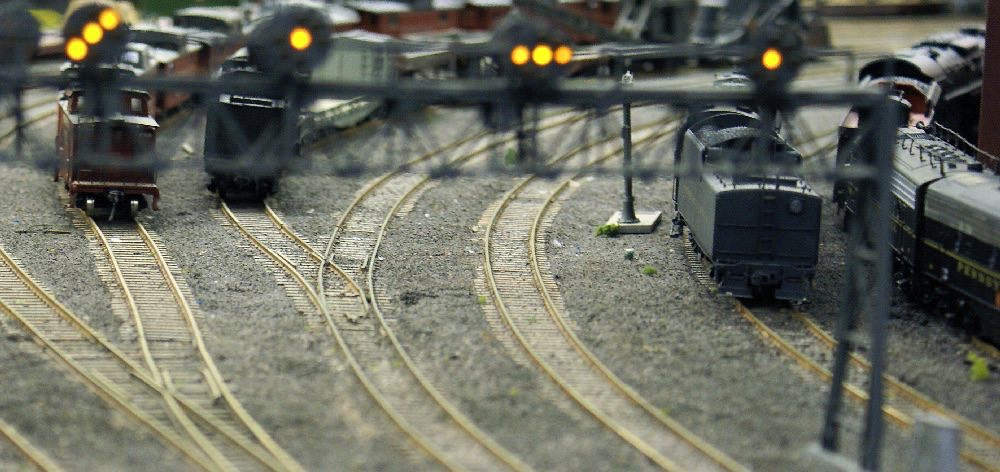
Altoona
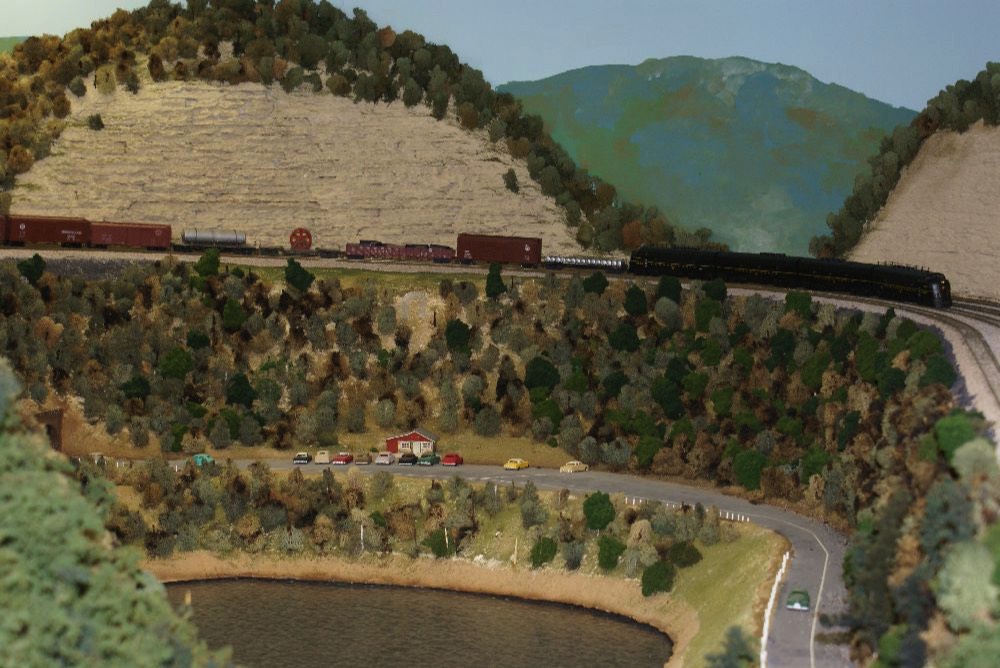
Horseshoe Curve
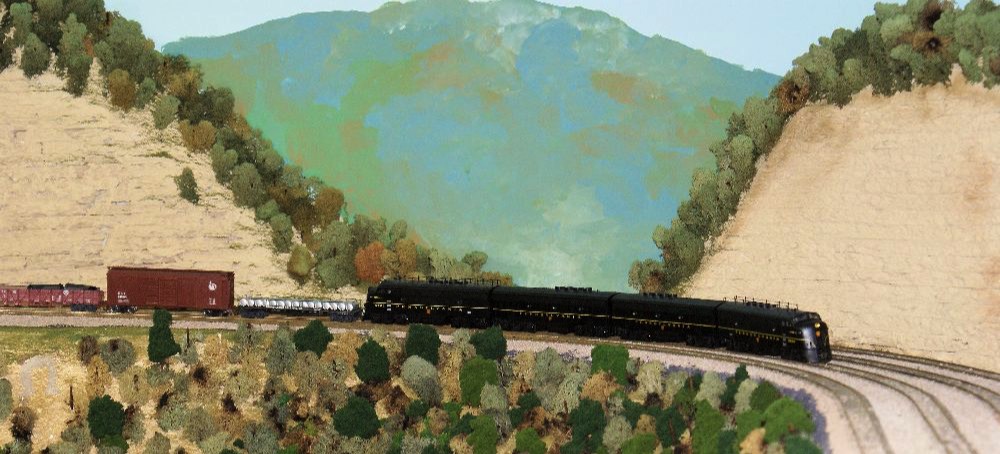
Horseshoe Curve
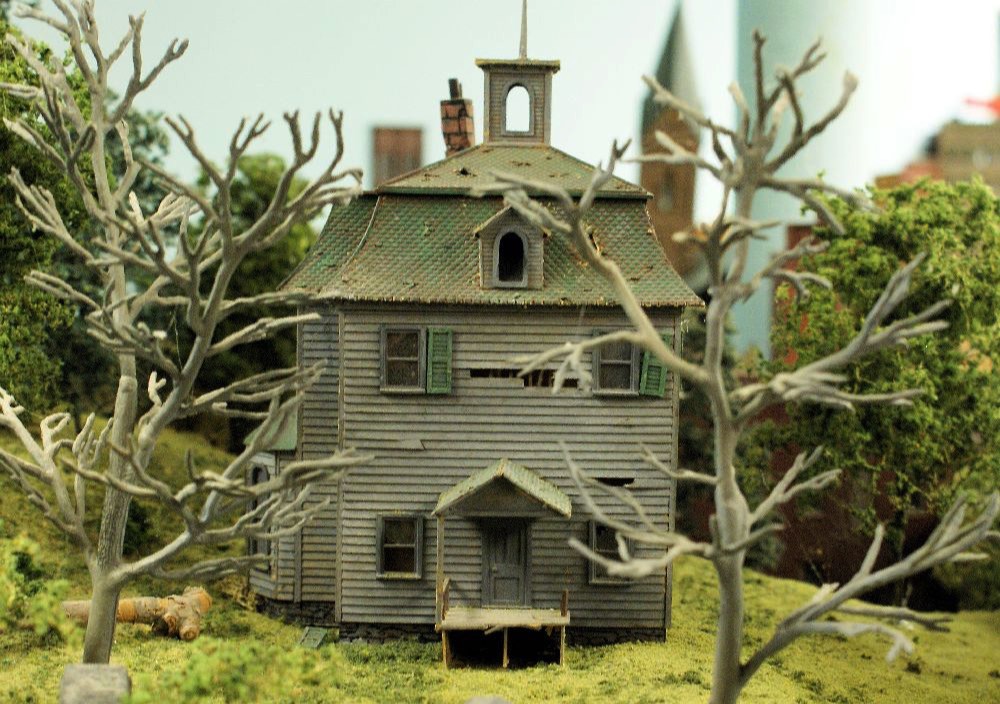
Alexander Models haunted house, built for a class project in 1961
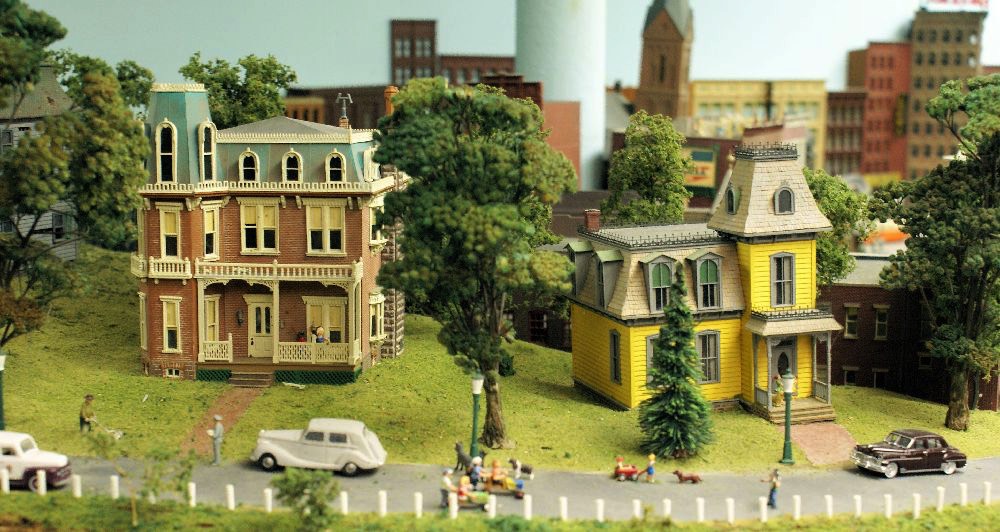
Victorian house
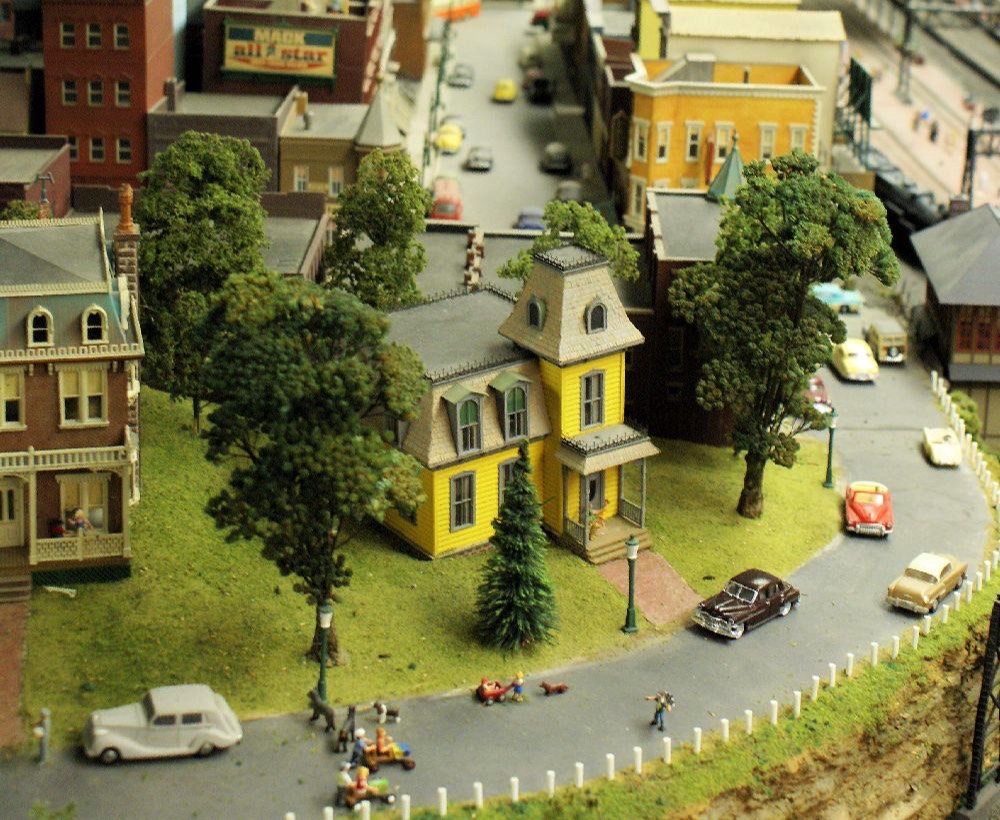
Altoona

Altoona
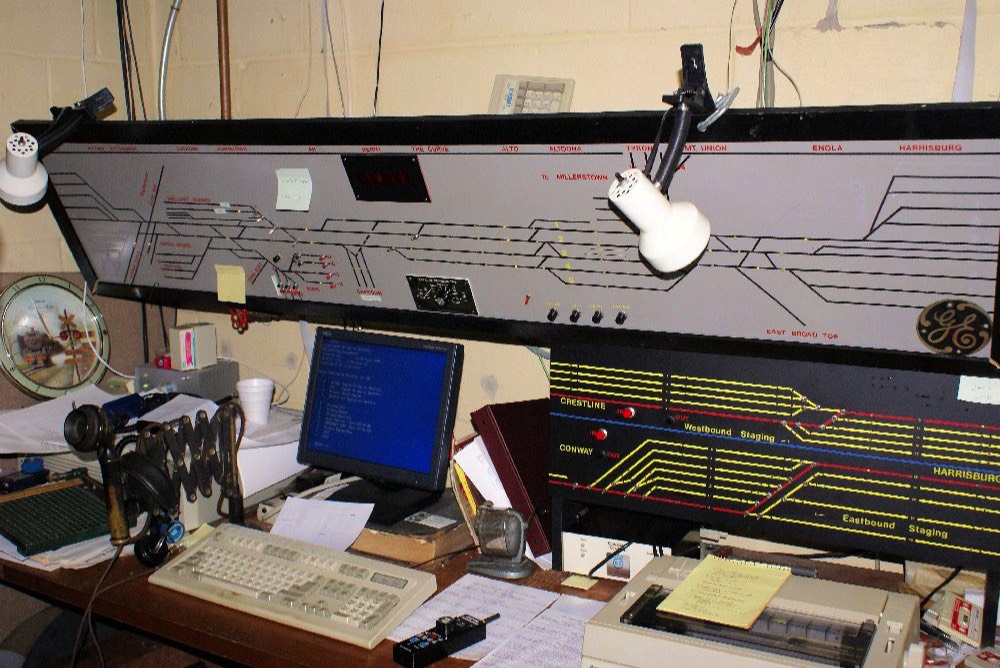
Dispatch Panel
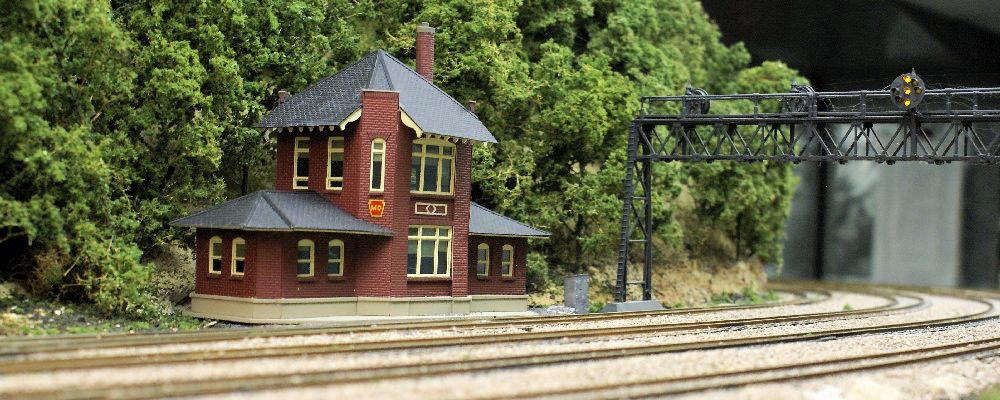
Tower MG
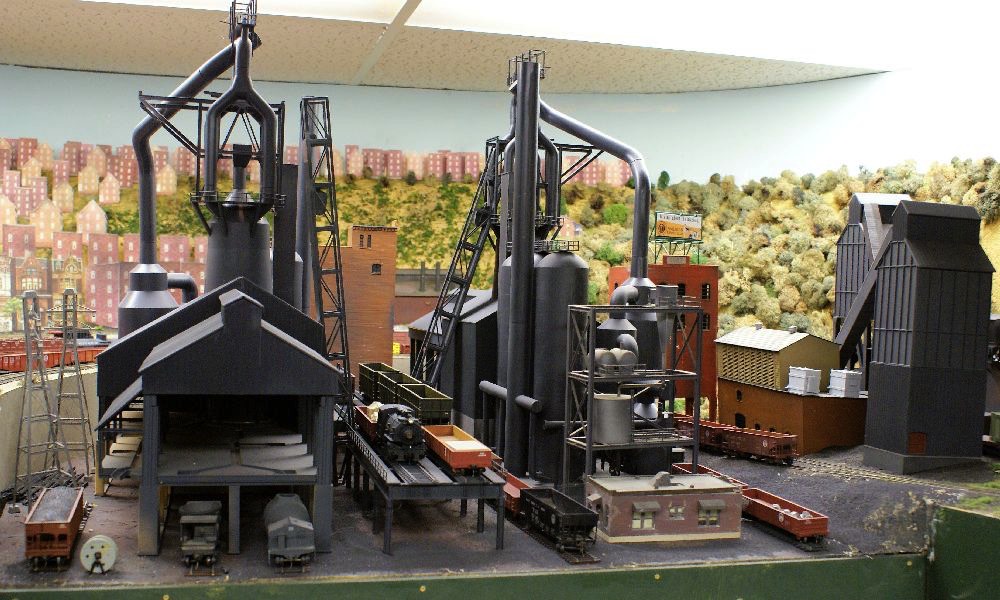
Johnstown
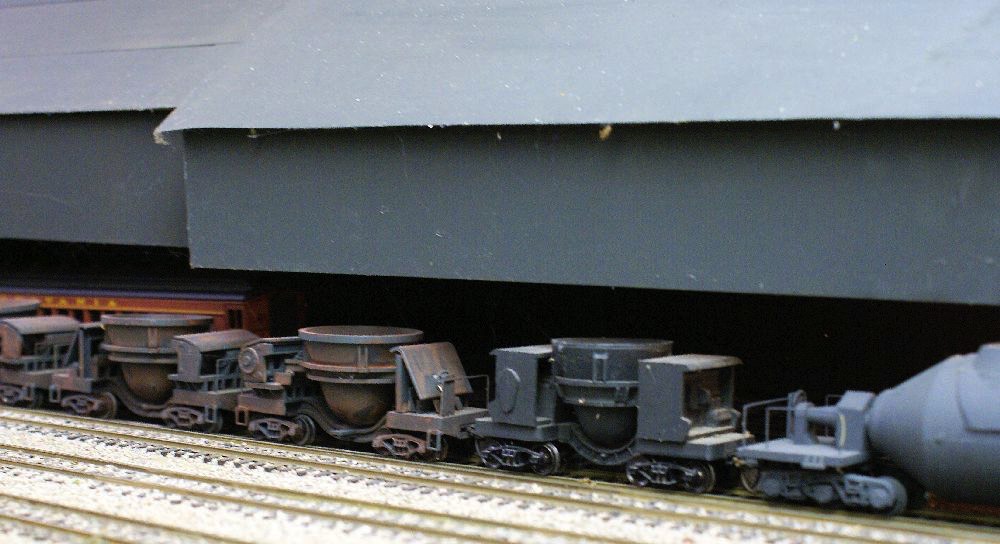
Johnstown
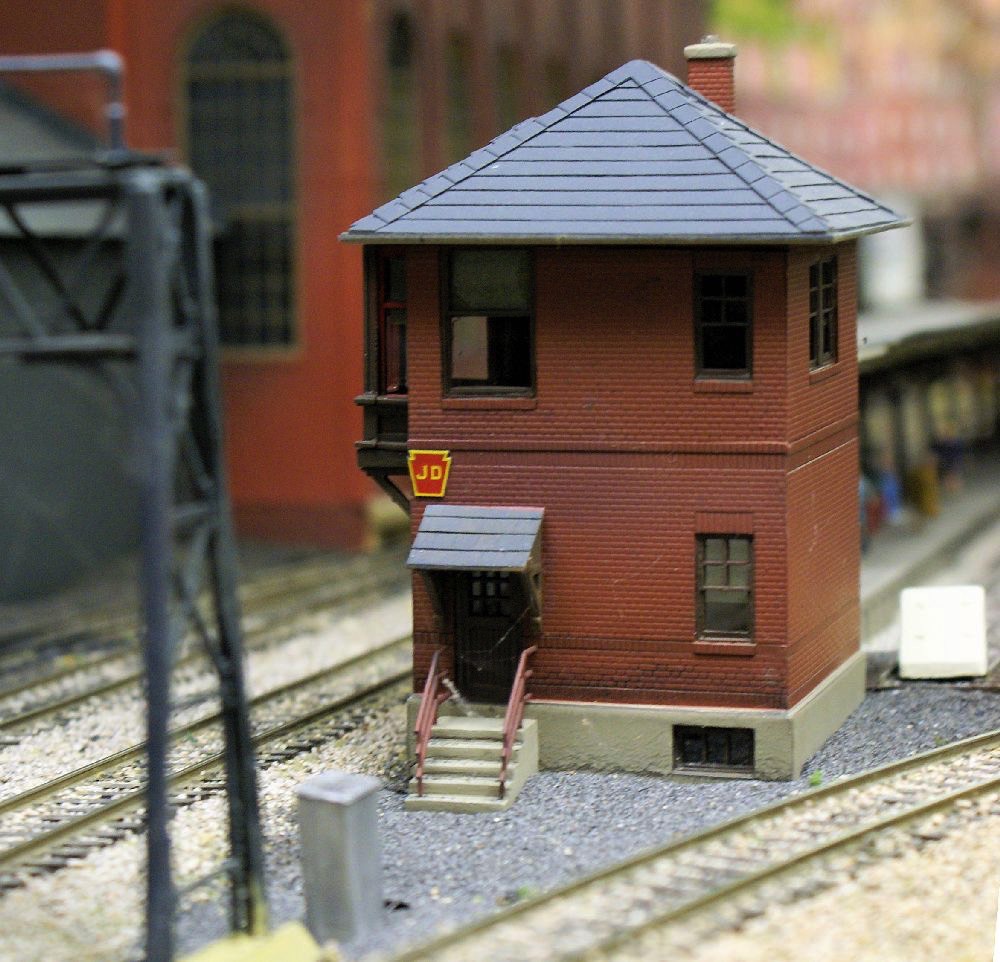
Tower JD
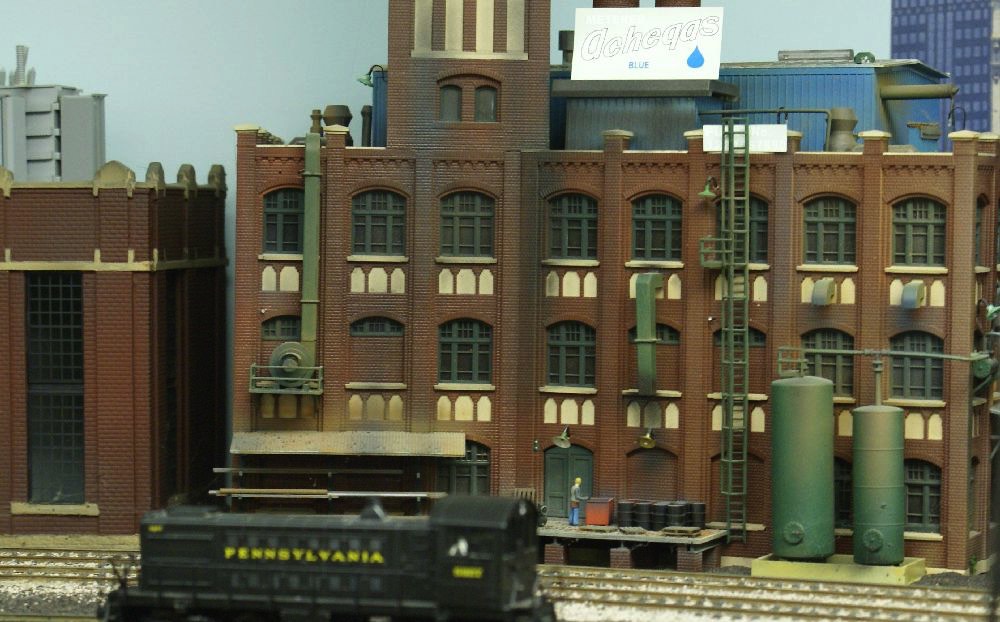
Achegas at Pittsburgh
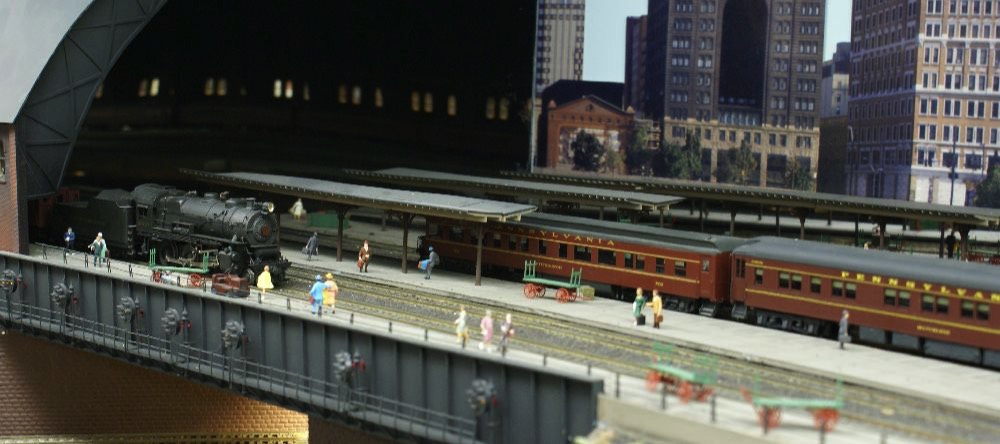
Pittsburgh passenger terminal

Downtown Pittsburgh
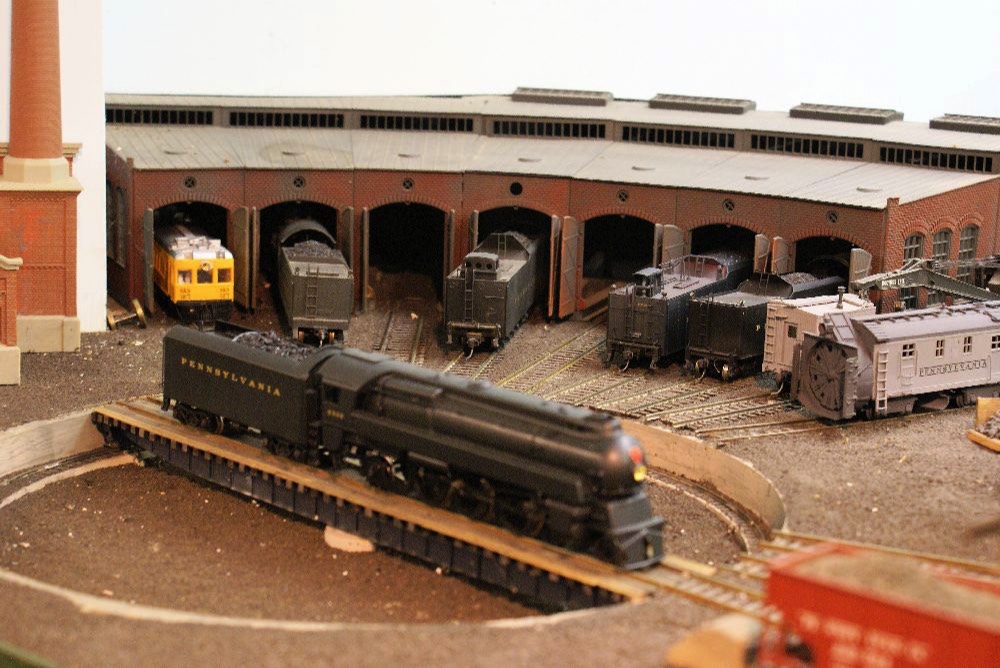
Pittsburgh roundhouse
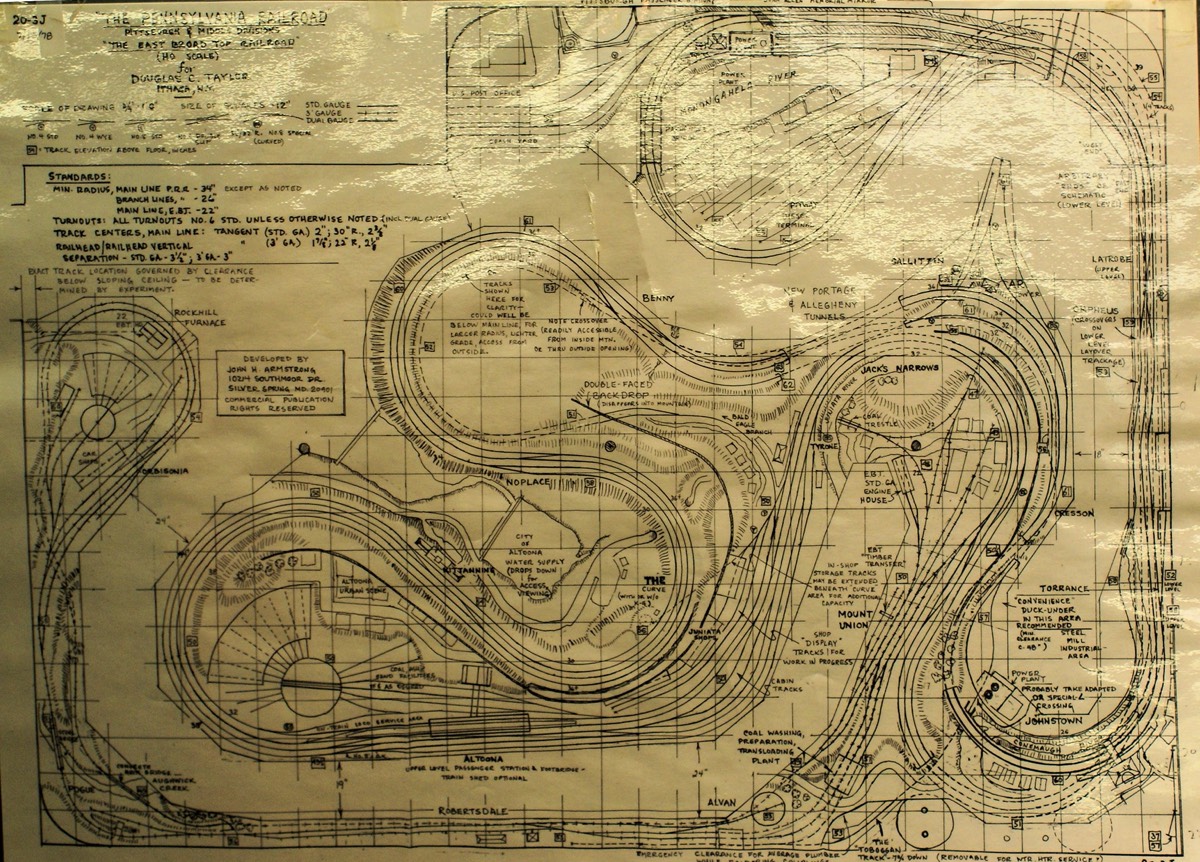
Original John Armstrong plans for the PRR

John Armstrong schematic for the PRR

